











Whether by train, plane, or automobile, Voyager changes the rules of traveling with ski equipment.




Editor in Chief: Miran Ališič
Publisher: Korpmedia d.o.o. Tomšičeva 1, 1000 Ljubljana, Slovenia www.korpmedia.si
Registration No.: 2272237000 VAT No.: SI14601737
Client Coordinator: Primož Jurman
Photo Editor: Bor Dobrin
Art Directors: Slavojka Akrapovič, Neja Engelsberger, Saša Kerkoš
Cover design: Zdenko Bračevac Design: Zdenko Bračevac, Andrej Perčič, Bojan Perko, Jan Mohorič, Akrapovič Kreativa d.o.o.
Content Editor: Jasna Milinković
Contributors: Alenka Birk, Tony Dodgins, Matevž Hribar, Matej Isak, Primož Jurman, Gaber Keržišnik, Mat Oxley, Matej Akrapović, Miran Ališič, Mitja Reven, Federico Tondelli, Tina Torelli, Jean Turner

Contributing Photographers: Akrapovič, Alex Štokelj, BMW, Bor Dobrin, chili films, Cirrus, Ducati, Federico Tondelli, Gaber Keržišnik, Graeme Brown, Honda, Marc Robinot, Polarity Photo, Matej Povše, Matevž Hribar, Tidal Audio, Uroš Podlogar, Yamaha, Žan Rek











Translation: Matjaž Horvat, Werner Schneider Proofreading: Tim Walpole
Ad space marketing: www.yvision.ch Y.Vision GmbH, Poststrasse 9, 6300 Zug, Switzerland
On the cover: Slip-On Line (SS) for the Ducati Scrambler Urban Motard / Nightshift / Icon / Icon Dark / Desert Sled
Photo: Alex Štokelj
Printing: LUart, Lepovče 42, 1310 Ribnica, Slovenia
// Si


NOTE All the longer articles in the Akrapovič magazine include a text that will be marked with the // Si sign and placed in a special frame. The Akrapovič company is based in Slovenia and this is why we decided to keep this part of the text in Slovenian as well.
This magazine and its entire textual and pictorial content are subject to copyright. Any reproduction thereof without prior written consent of the copyright holder is prohibited. The views and opinions expressed herein do not necessarily reflect the opinions of Akrapovič d.d., the publishers or the editors. Not for sale. Printed in Slovenia in November in 6,000 copies.
General Warning Because of the world-wide distribution of Akrapovič d.d. products, neither Akrapovič d.d. nor any of its subsidiaries make any representation that the products comply with the air and/or noise emissions laws, or labeling laws, of any jurisdiction. The purchasers are entirely responsible for informing themselves of the applicable laws where the products are to be used and to comply with those laws. Warning / USA Various U.S. states and the U.S. federal government have individual laws regulating the use of aftermarket exhaust parts and systems, especially as those parts and systems modify, remove, or replace original equipment catalysts. Please consult the appropriate laws in your area before installing any aftermarket part or system on your vehicle to ensure compliance with all applicable laws. Neither Akrapovič d.d. nor any of their subsidiaries or the sellers of the parts or systems make any representation that any of their parts or systems comply with any such laws. Warning / California California laws prohibit the use of any aftermarket exhaust part or system that modifies, removes or replaces original equipment catalysts unless the California Air Resources Board has issued an Executive Order regarding such part or system or unless the part or system is exempted by being used only on racing vehicles on closed courses. Neither Akrapovič d.d. nor any of their subsidiaries make any representation that any of their parts or systems has received such an Executive Order or that any of their parts or systems conform with the racing vehicles exemption. The purchasers are entirely responsible for
applicable California laws and to comply with those laws.

It is hard to believe that the acronym VUCA (Volatility, Uncertainty, Complexity and Ambiguity) was created all the way back in 1987 to describe a world that was becoming increasingly unpredictable and complex as the Cold War drew to a close. Although the changes back then were certainly unsettling for some, the sense of unpredictability at that time was, in my opinion, mainly due to numerous new opportunities that were rapidly appearing after the fall of the Iron Curtain and the simultaneous emergence of the Internet. Unlike that ‘golden’ era, we live in a VUCA world on steroids today, as risks to which we are exposed keep increasing. Unwelcome news seems to be coming fast and thick recently: the Covid-19 virus, disruption of global supply chains, war on European soil, shortages and rising energy prices. A nightmare for all of us, and even more so for the financiers, who must evaluate these changes in monetary terms. But after two years of quarantine, people are now craving to socialise and relax. We are overjoyed that, among other things, we can once again watch a race live and hang out with friends after far too long of a break. Akrapovič has, meanwhile, been ‘hanging out’ with our friends from MotoGP for 20 years; it was in 2002 that the company entered the premiere class of motorcycle racing. Over the period, we have collaborated with many teams and racing legends and I am glad that MotoGP has retained its fans from all around the world even as new names appeared on the track. To find out more, the story of Akrapovič and MotoGP is detailed later in this issue.
I like to say that today's world is becoming increasingly like racing in the competitive motorsport classes that we love so much. Each turn presents a new challenge and an unpredictable situation from which only the best emerge as winners. But just who tomorrow’s winner will be in an unpredictable world depends on the ability to adapt to changes and the passion to pursue the goals. Akrapovič has been passionately working for you for the past 30 years and will continue to do so in the future.
However, to continue to be successful as a company, we must be able to adapt to the unpredictable and allow development to passionately work for a better tomorrow. Relying on a single technology proved risky during this energy crisis and, in the absence of alternatives, led to a return to old technologies that we had already given up on. From this point of view, the decision by the MotoGP and Formula 1 series to switch to synthetic fuels in the coming years is a step in the right direction, as it allows looking for alternative solutions in addressing the same issue, i.e., ensuring a cleaner environment for posterity.
Dear readers, it is good to have at least some constancy in today's unpredictable world. As the season for outdoor motorcycle ventures winds down, we want to keep you warm in the ever-colder days with a tried and tested mix of excellent interviews, interesting stories from the world of car and bike sports and a few bonuses from Akrapovič that herald the new season. I believe that reading ALM, already in its 33rd issue, is one of those pleasant habits that many will cherish today and many years from now, because the best things are timeless, even in today's VUCA world.
photography Bor Dobrin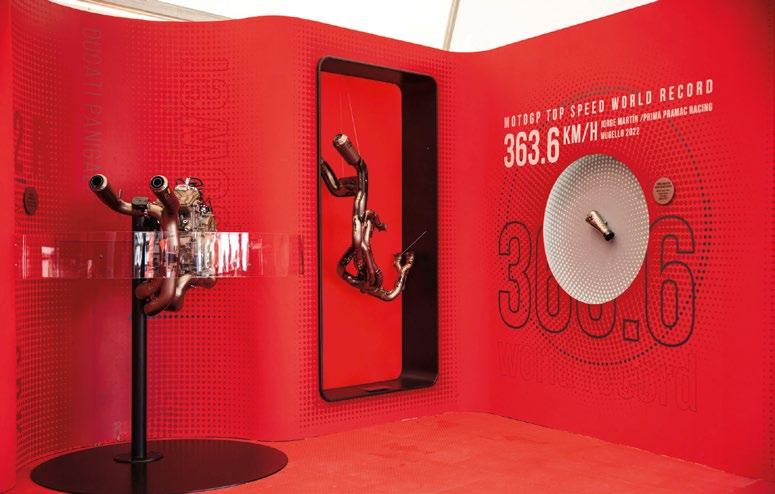
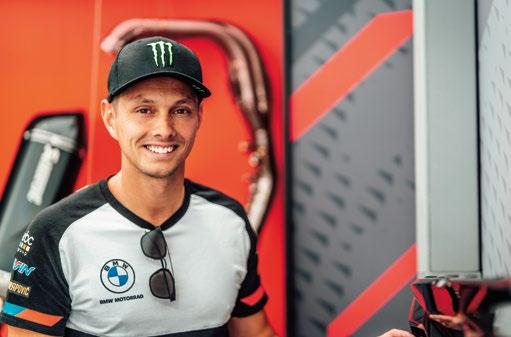
In July, Akrapovič, for the first time ever as an event partner, took part in World Ducati Week, a must-go-to event for all Ducati lovers that was held in Italy at the Misano World Circuit Marco Simoncelli. During the three-day event, Akrapovič showcased its exhaust systems for Ducati motorcycles in a red-clad exhibition area under the slogan ‘Trusted Partnership for Challenging Conditions’ which served to confirm the close connection between the Slovenian company and Ducati which cooperate both in racing and commercial segments. It therefore came as no surprise that the Akrapovič stand was full of riders competing in various classes of motorcycle racing, such as MotoGP, WorldSBK, and WorldSSP. Area visitors were more than happy to get their autographs as well as a chance to get close and personal with Francesco Bagnaia’s (Ducati Lenovo Team) MotoGP racing motorcycle and a genuine part of the exhaust that Jorge Martín (Prima Pramac Racing) used when he broke the MotoGP speed record at Mugello in Italy, earlier this year with a speed of 363.6 km/h.
The 20 th annual festival for BMW Motorrad lovers took place in July in the German capital, Berlin, with Akrapovič presenting its latest collection of products for BMW motorcycles. Visitors to the Messe Berlin Summer Garden could feast their eyes on the company’s renowned titanium exhaust systems for the entire range of BMW motorcycles – from the S 1000 RR to the R 1250 GS – as well as admire an innovative product, lightweight titanium protection bars for the renowned GS model. The Slovenian company exhibited at the BMW Motorrad Days for the 14th time and, the same as before, many racing riders showed up at its exhibition area. The high-profile visitors included the BMW Motorrad WorldSBK Team and BMW Motorrad World Endurance Team riders, who were mainly drawn to Peter Hickman’s (Gas Monkey Garage by FHO Racing) 2022 Isle of Man TT Senior racewinning BMW M 1000 RR, itself one of the main stars of the event.
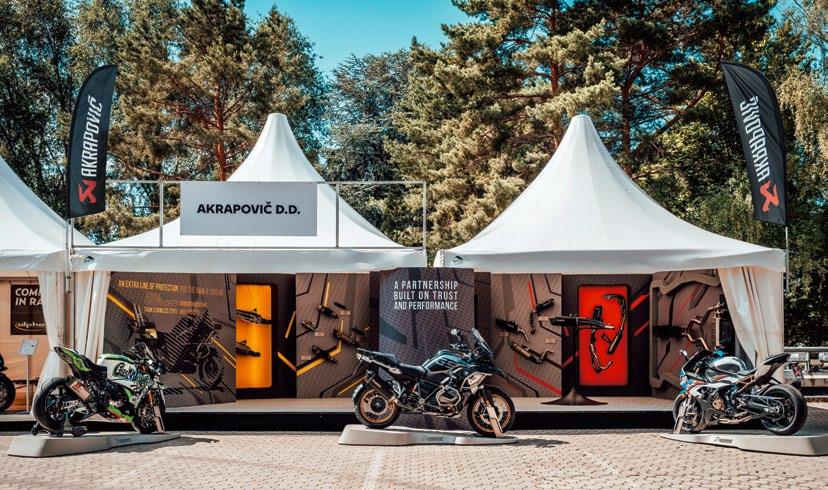

It is almost impossible to envisage a better place to unveil a new generation of off-road exhaust systems than the famous Red Bull Erzbergrodeo, the world’s toughest Hard Enduro World Championship race. Apart from showcasing new products, inspired by the company’s extensive racing experience from the world’s hardest races, the Slovenian performance exhaust system specialist was once more an official partner of this four-day event, which, as usual, took place in the picturesque setting of the Erzberg iron mine in Styria, Austria. The race itself, filled with fast sections, countless turns, puddles, loose gravel, large sharp boulders, rocks, roots, and other obstacles, was won by Manuel Lettenbichler (Red Bull KTM Factory Racing), whom, as well as other competitors, the spectators could admire at the Akrapovič Oneon-One Rider Presentation.



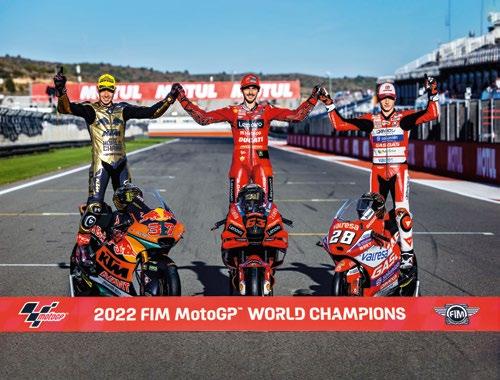
2022 already has and will bring even more world championship titles to riders on machines equipped with exhaust systems from Ivančna Gorica. Akrapovičs tally stood at 153 world championships by the end of the 2021 season, a number that has exceeded 160 by October 2022. This years counter was put into motion by Andrea Verona (GASGAS Factory Racing), who convincingly won the 2022 Enduro 1 and EnduroGP classes of the FIM EnduroGP World Championship, and Zach Pichon (Sherco CH Racing) who was crowned the FIM Junior Enduro World Champion during the same weekend. Another off-road title followed, courtesy of Tom Vialle (Red Bull KTM Factory Racing) who won the MX2 class in the FIM Motocross World Championship.
The second weekend in October brought two more titles, with Alvaro Diaz (Arco Motor University Team) becoming the new king of the FIM Supersport 300 World Championship and Manuel Lettenbichler (Red Bull KTM Factory Racing), also riding on an Akrapovič equipped motorcycle, winning the FIM Hard Enduro World Championship. Sam Sunderland, who won this years Dakar, polished off a perfect season with a FIM World Rally-Raid Champion title. The group photo of the champions in the Moto3, Moto2 and MotoGP classes again featured riders with Akrapovič-equipped racing machines: Izan Guevara (Gaviota GASGAS Aspar Moto3 Team) in the FIM Moto3 World Championship, Augusto Fernandez (Red Bull KTM Ajo) in the FIM Moto2 World Championship and Francesco Bagnaia (Ducati Lenovo Team) in the FIM MotoGP World Championship.
Photo: GASGAS Images / Future7MediaPeter Hickman made history at this year’s Isle of Man TT with a grand total of three victories. The Gas Monkey Garage by FHO Racing rider and his BMW M 1000 RR, equipped with a lightweight Akrapovič titanium exhaust system, won the Superbike and Superstock classes before completing the hat-trick by winning the prestigious Senior TT that closed the event. “Three victories at the Isle of Man TT are a great result for us as a manufacturer,” said BMW Motorrad Motorsport Director Marc Bongers, who was undoubtedly pleased that the M 1000 RR won already at its first appearance at the Isle of Man TT.

Team HRC riders Tetsuta Nagashima, Takumi Takahashi and Iker Lecuona were the big winners of this year’s Suzuka 8 Hours. The riders on an Akrapovič-equipped CBR1000RR-R Fireblade SP overtook the second-placed team by a full lap and brought Honda its 28 th victory at this prestigious race.

We have gotten used to Pol Tarrés doing things with a motorcycle that many earthlings could not imagine doing even in their wildest dreams. One of Pol’s adventures this year was a ride to Cerro Mercedario, one of the highest peaks of the Andes, which earned him a spot in the Guinness World Records book. Why? His Yamaha Ténéré 700, fitted with an Akrapovič exhaust system, reached the highest point ever recorded for a twin-cylinder bike at 6,157.5 metres above sea level.

 11,479 readers of the printed and online edition of PS magazine chose Akrapovič as the best brand in the category of exhaust systems this year with 81.4% of the vote. This is the 15th consecutive Best Brand award bestowed by the prestigious German magazine upon Akrapovič.
11,479 readers of the printed and online edition of PS magazine chose Akrapovič as the best brand in the category of exhaust systems this year with 81.4% of the vote. This is the 15th consecutive Best Brand award bestowed by the prestigious German magazine upon Akrapovič.
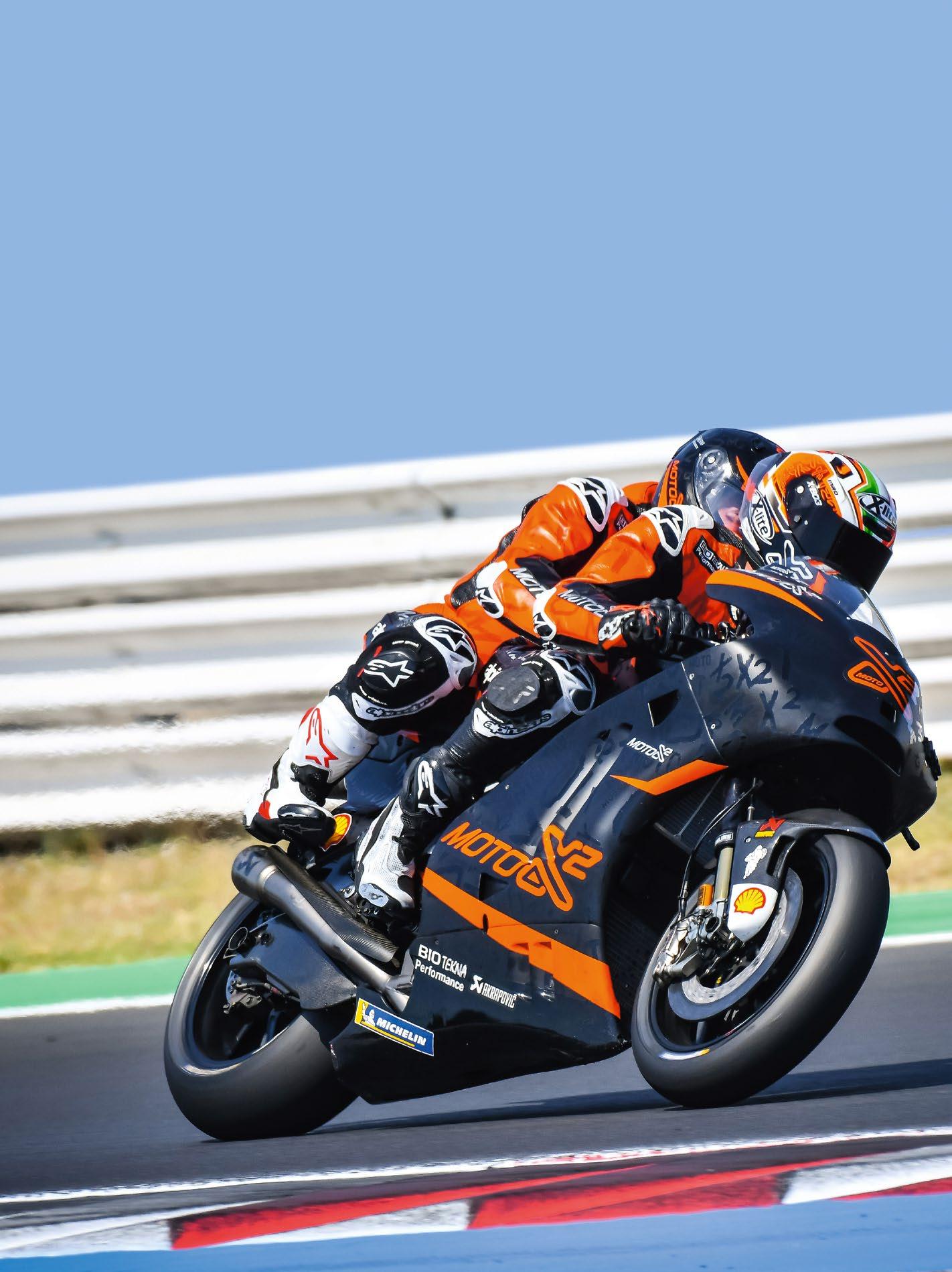
Ducati has been offering this truly fantastic experience to the lucky few for more than 20-years at the side-lines of MotoGP events, currently using the Desmosedici GP X2, a converted two-seater with safety grips on its fuel tank and featuring an Akrapovič exhaust system.
I was lucky to be able to sit behind Franco Battaini, a former 250cc and MotoGP racer, on the 1000cc machine with 184kW (250hp) at the Misano racetrack during the 11th World Ducati Week, which, following a four-year hiatus, attracted 80,000 enthusiastic Ducati fans from all over the world. Before we took off, he simply told me to follow his movements on the motorcycle with my body and keep my eyes on the exits from the turns.

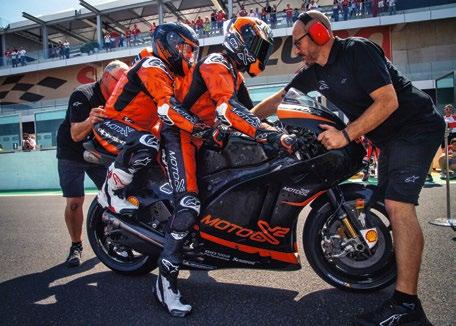
The mechanics (two per motorcycle) started the machine. The sharp Ducati MotoGP engine sound erupted from the Akrapovič exhaust and I’m sure that the roar caused some of the passengers’ knees to buckle. It’s for real now, there’s no turning back. My mouth dries up, my hands inside the gloves begin to sweat, a rush of adrenaline surges through my body. I’m both anxious and excited, but mainly really looking forward to the experience. I imagine riders liningup on the asphalt that reaches more than 40°C before the start of a race, which is, incidentally, 27 laps long in Misano – a hellish 27 laps! Motorcycles are brought to their positions, the ground shakes from the noise, spectators watching from the stands. Franco and Francesco Bagnaia (Ducati Lenovo Teams’s MotoGP star) ride off with their first passengers in a precisely determined routine. Passengers are assisted by a team that checks whether they put on their gear correctly and I also keep checking whether my helmet and my gloves are safely fastened. Next! Number three. Hey, that’s me!
I climb on the saddle. It’s hot because the top part of the exhaust system is routed under the seat. I smell burnt rubber, gasoline, heat. I grab the grips on the fuel tank and Franco takes off. He checks whether I’m sat correctly and opens the throttle. The engine roars, the front wheel lifts and we cross the finish straight doing a wheelie. Before taking the ‘Variante del Parco’ set of turns, Franco slows down, brakes hard and leans to the right. Lower, then lower
still. The tyres grip the track tightly, Franco accelerates on the exit and we are doing a wheelie again. Then we speed through the fast ‘Rio’ set of turns and, try as I might to focus on the exits, I can only see parts of the track and the kerbs as my body movement follows Franco’s. Then we hit a short straight, which ends with braking for the ‘Quercia’ corner. I begin to feel my hands as I cling to the handles, my breathing is shallow, I fight forces that my body is not used to fighting. There’s no time to think. Before the back straight, we pass through ‘Tramonto’ a set of right turns, and gain on Francesco with his passenger in front of us. Accelerating out of the turns is brutal, the ‘Curvone’ straight where we reach up to 250 km/h ends in a righthander, and is the place where heroes are made during the race. The motorcycle feels stable, it roars, it feels like it’s bursting at the seams with power. Completely different from when I took to this track on a test bike two months ago. Hard braking before the ‘Curva del Carro,’ the lean angles are incredible and then it’s already time for the last Misano corner and another wheelie before we cross the finish line with a stoppie. A bit for the show, a bit for the adrenaline. I thank Franco by patting him on the back, jump off the motorcycle, go to the side of the track and… take a deep breath. Here I am, at the finish line, having had a unique experience that left me with trembling hands, a wide grin and an already awakened desire to repeat this unforgettable ride.
Have you ever wondered what it's like to ride on the back of a MotoGP motorcycle, a prototype that represents the pinnacle of technology on two wheels? What awaits and what emotions arise in someone who gets the chance of a lifetime to sit behind a top-class racing rider and do a lap or two?
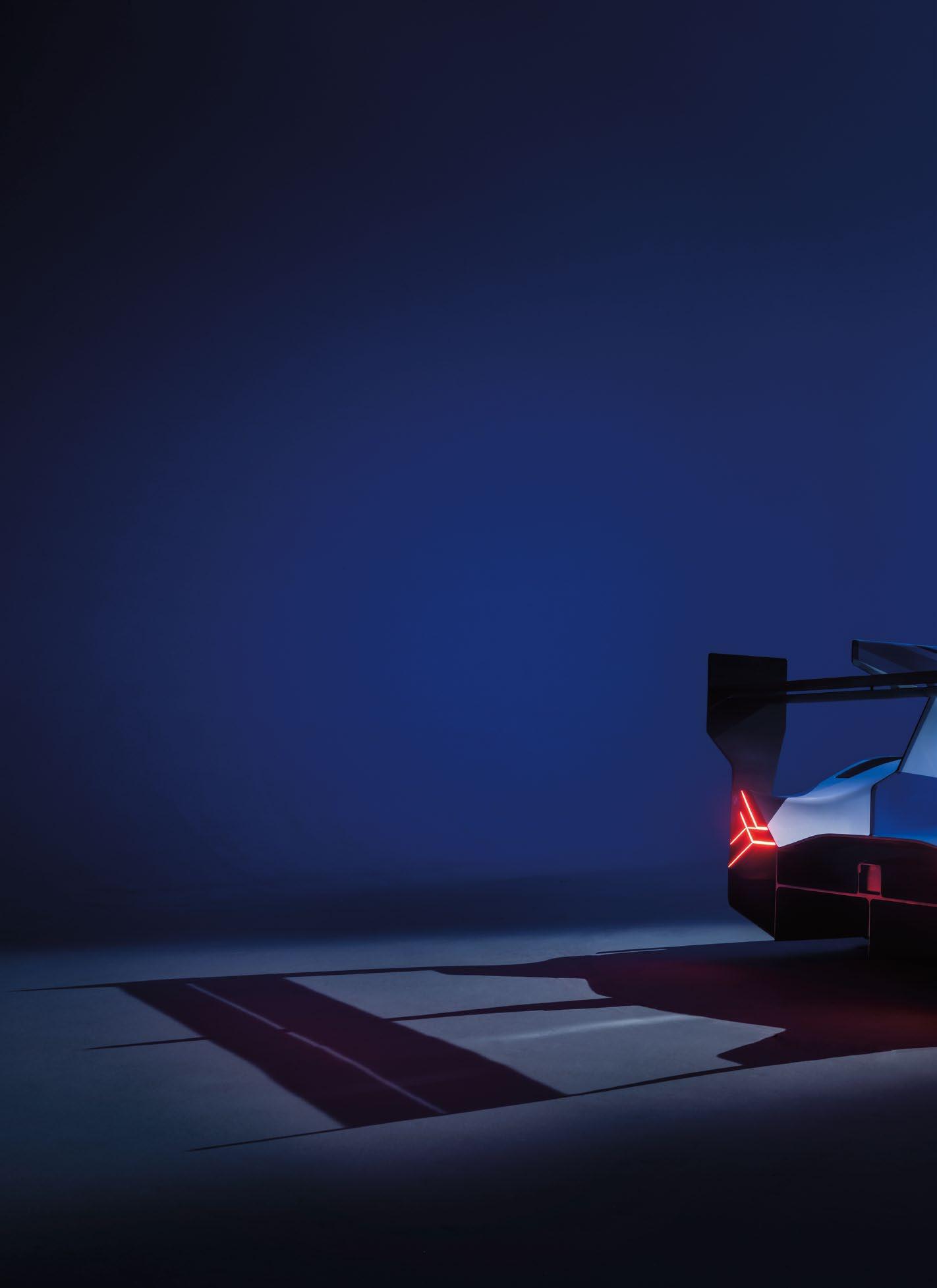
In September BMW unveiled its all-new BMW M Hybrid V8 racing car at the Petersen Museum in Los Angeles, USA. Painted for the first time in its racing colours, in which it will compete in the GTP class of the IMSA WeatherTech SportsCar Championship in 2023, the first prototype developed by BMW M Motorsport in 25 years also contains Slovenian know-how.

January 2023 will see Connor De Phillippi, Philipp Eng, Augusto Farfus, Nick Yelloly, Colton Herta, Sheldon van der Linde and Marco Wittmann of BMW M Team RLL fight for glory at the 24 Hours of Daytona with two BMW M Hybrid V8 prototypes. Akrapovič will meanwhile begin its 12 th racing season as the official partner of BMW M Motorsport and the partnership between the Slovenian and German brands has never been stronger. Following joint racing exhaust projects for the legendary BMW M3 DTM, BMW M4 DTM, BMW M6 GT3, BMW M8 GTE and BMW M4 GT3, the engineers at BMW M Motorsport and Akrapovič have now created an exhaust system for the all-new BMW M Hybrid V8, the cherry on top of a very fruitful cooperation that resulted in DTM series titles, victories at 24hour races on legendary racetracks and many other triumphs.
“It’s great to witness the speed of the new BMW M4 GT3 this season, where BMW M Motorsport and Akrapovič joined forces in
creating the exhaust system for this customer racing car. When the colleagues from Munich asked us if we wanted to collaborate on the exhaust system for the BMW M Hybrid V8, the answer was a foregone conclusion. We love technical challenges and we are extremely motivated to be working with BMW M Motorsport on such an exciting project as an LMDh racing car,” Uroš Rosa, CEO of Akrapovič, said at the sidelines of the unveiling of the new Bavarian racer.
The sheer amount of motivation of being able to play a part in the project to create a racing car like the BMW M Hybrid V8 was also clearly felt in the words of Andreas Roos, Head of BMW M Motorsport: “Being back in the top class of motorsport and battling for overall victories at such legendary races as Daytona, Sebring and Road Atlanta in 2023 is both a major challenge and huge motivation for everyone at BMW M Motorsport.”
The BMW M Hybrid V8 is powered by the P66/3 eight-cylinder, four-litre turbo engine with a supplementary electric drive. The combustion engine is based on the DTM unit used in the BMW M4 DTM in 2017 and 2018,
which came with an Akrapovič exhaust system, so participating in the LMDh programme was a logical follow-up.
The two drive components were connected in the car for the first time at the end of June 2022 and the BMW M Motorsport racing car, with the chassis developed at Dallara, has since then been undergoing accelerated testing, which began in Italy and Spain before moving to the USA, including the Sebring racetrack, famous for its unforgiving surface. The car has already been evaluated by many BMW works drivers in hot, dry, rainy and colder conditions to get as much information as possible about its handling. Test drivers who have already sat behind the wheel of the all-new BMW M Hybrid V8, include Akrapovič brand ambassador Marco Wittmann.

Not only is the BMW M Hybrid V8 a technical masterpiece, but it is also work of art visually, packed to the brim with details that aim to contribute their share to its speed. Because of all these beautiful details, choosing where to sit at the 24 Hours of Daytona can pose a bit of a problem – would you rather see it in all its glory near the pit lane, where its speed will be the lowest, or would you rather be in the stands of the legendary oval and hear the amazing sound of the eight-cylinder coming from Akrapovič exhaust pipes as it whizzes by?
“When the colleagues from Munich asked us if we wanted to collaborate on the exhaust system for the BMW M Hybrid V8, the answer was a foregone conclusion.”
Uroš Rosa, CEO Akrapovič
World Superbike (WorldSBK) and World Supersport (WorldSSP) class racers ride on bikes derived from motorcycles available for sale to the general public, so they represent a welcome promotion for motorcycle brands and strengthen their brand awareness. The ‘Win on Sunday, buy on Monday’ mantra is also ingrained in the rules of both classes, though the more powerful WorldSBK class allows for a larger extent of modifications than WorldSSP.
The WorldSBK Championship was launched in 1988. It uses racing bikes which are modified versions of models available for sale to customers – unlike the MotoGP class where racers use prototype bikes. MotoGP is the motorcycle world’s equivalent of Formula 1, while Superbike is more similar to sports car racing. WorldSSP began in 1997 and takes place within the WorldSBK framework. This class only allows for minor modifications to the original bikes, which is also reflected in exhaust
system development. The rules for both classes state that exhaust system mufflers must remain on the same side (left or right) as on the models available for sale to the general public, and that the number of mufflers also stays the same. But rules for the two classes are not the same: namely WorldSBK has more freedom for modification than WorldSSP. Akrapovič provides exhaust systems to both classes, so we inquired about the similarities and differences in exhaust development for the two.




 by Primož Jurman photography Graeme Brown
by Primož Jurman photography Graeme Brown
Computers are essential
Miha Jeraj, Head of Project Office, Racing R&D at Akrapovič, said: “Serially produced motorcycles are becoming more and more sophisticated. Racing departments are keeping pace and increasingly focusing on computer simulation and planning, even before the first test lap is taken on the track. Works teams competing in WorldSBK receive strong support from motorcycle manufacturers, who provide a dedicated team of engineers for the development of racing machines. In recent years, in the WorldSBK class, almost all exhaust systems were first created in a 3D environment, the backbone for manufacturing exhaust system prototypes. These are then tested on a dynamometer, whereupon a 3D version is produced which then undergoes additional modifications to become an exhaust system ready for race use. Since racing motorcycles are based on production models, the basic design of the exhaust does not change much during the season, though one development cycle is usually carried out every year to adapt the exhaust to, let’s say, a new rear swingarm, a new radiator or to increase its power.”
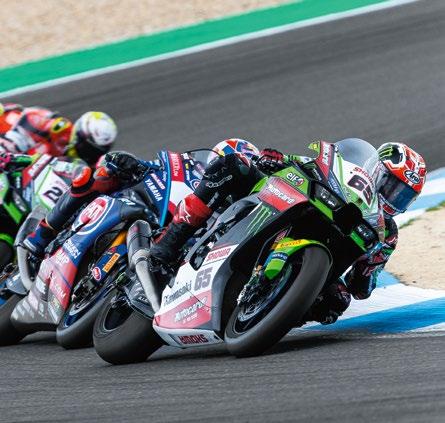


Miha also says that Superbike exhausts undergo a radical change approximately

every two years, while adjustments of various components can happen between three and ten times a year. This particular number is higher when a manufacturer starts using a new motorcycle model. One such example is the Honda CBR1000RR-R Fireblade SP where nine different versions of the exhaust, significantly different from one another, have been used in its three years of racing. On the other hand, Kawasaki has been using a similar exhaust system with some minor adjustments for the last few years, since the underlying motorcycle has remained almost the same since 2016. BMW meanwhile introduced its new S 1000 RR in 2019 and its exhaust remained practically the same in its first season as the one that a customer could buy in a shop. However, following further development of the motorcycle’s engine (in 2021 BMW launched the new M 1000 RR), the exhaust also changed and is in its fourth iteration at the moment. It should be mentioned that each change to the motorcycle requires tests on the dynamometer, with about 500 runs and between five and ten prototypes per version! This is the expected number of prototypes during the two to three months development cycle of an exhaust system for a WorldSBK bike.

Aruba.it Racing − Ducati
Barni Spark Racing Team
BMW Motorrad WorldSBK Team
Bonovo action BMW Racing Team
B-Max Racing Team
GIL Motorsport Yamaha GYTR GRT Yamaha WorldSBK Team
Kawasaki Racing Team

Pata Yamaha with BRIXX WorldSBK Team HRC
Yamaha Motoxracing Worldsbk Team
WorldSSP:
Aruba.it Racing WSSP
Barni Spark Racing Team GMT94 Yamaha Kallio Racing MTM Kawasaki MV Agusta Reparto Corse
Let’s turn to the development of WorldSSP exhaust systems. How does that compare? “WorldSSP class motorcycles change less often. This is the case for Yamaha R6, where the basis of the motorcycle has remained the same for many years, thus also requiring fewer changes to the exhaust. Here customers can purchase practically the same exhaust system as the one used by the racing teams. Manufacturers get involved in WorldSSP to a lesser direct degree than in WorldSBK. When Ducati entered WorldSSP, the exhaust for the Panigale V2 was made specifically for the class and we devoted a lot of time to meet the regulations on loudness, which are quite restrictive for this category. In 2022, we produced three muffler versions to arrive at a favourable compromise between engine loudness and power. A special feature of this development was adjusting the power curve, as Ducati, due to the limitation of the model’s maximum power stipulated in the regulations in order to bring performance closer to other less powerful motorcycles, wanted a different torque curve to exploit the larger torque of this particular engine type. We managed to provide just that through extensive testing of prototypes on a dynamometer. In total we performed 400 dynamometer runs and produced five prototype exhausts.”
Miha also reveals that the share of racers using Akrapovič exhausts in WorldSSP rose from 20% in 2011 to 31% in 2022 season, while the share of WorldSBK racers grew in accordance with the motorcycle manufacturers’ increasing trust and confidence in Akrapovič’s ability to produce even the most demanding exhausts, growing from about 30% in 2010 to 50% in 2015 and over 75% in 2022.

When champions cross the finish line ahead of the pack, they receive the vast majority of media and public attention. They are the victorious heroes who have proven themselves in the fight against the competition and they and their machines have triumphed over the rest. But, often unknown and working far from the limelight, are the guys and girls who spend days and nights looking for technological solutions and co-operating with works motorcycle brands to find new ways to make their riders and motorcycles go even faster – solutions that the champions make full use of. One such quiet guy in the background is Toni Mulec from Slovenia.


The turning point in his enduro career came in 2021, when he finished second in the silver category at the world’s most technically demanding off-road race, the Red Bull Romaniacs.

We caught up with Toni (whose surname means ‘The Kid’ in Slovenian) at a motocross track on a summer day in Semič in the south of Slovenia, where he was improving his skills on a KTM. Toni Mulec (born 1985) is a Slovenian motocross, enduro, crosscountry and rally rider as well as a test rider for the Austrian KTM brand and Akrapovič. Off-roading has been his passion since childhood. He was just finishing primary school when he first sat on a motorcycle and started competing in the Slovenian Motocross Championship. He says he was a bit late to the party, but maybe that’s his advantage – he just can’t get enough of motorcycles. In the following years, he was the Slovenian runner-up seven times and was selected for the national team competing in the Motocross of Nations, a kind of motocross Olympiad that gathers the best individuals and teams once a year. Enduro and cross-country followed in 2015, with Toni becoming the national champion in the latter four times so far. He was also part of the Slovenian team in classic enduro races, participating in the prestigious ‘Six Days’ race. His results were convincing enough to kickstart cooperation with KTM several years ago, while Akrapovič had set their sights on him even before that. Apart from being a staple at the Slovenian national cross-country races, he also competed with considerable success at the prestigious Le Touquet, Red Bull Romaniacs and Erzbergrodeo races, to name but a few. The turning point in his enduro career came in 2021, when he finished second in the silver category at the world’s most technically demanding off-road race, the Red Bull Romaniacs. He tried racing on sand for the first time in 2013 and his love for this
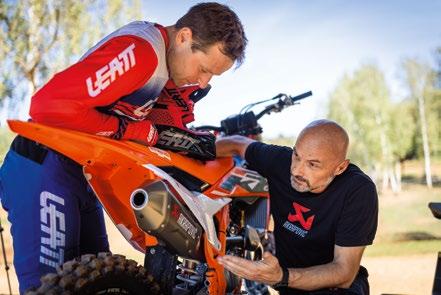

“As a test rider, I already had the opportunity to ride a rally motorcycle in the desert, which gave me even more motivation and the desire to participate in the Dakar.
I’ve never experienced the kind of freedom you feel on a motorcycle surrounded by sand. These are indescribable feelings, a kind of paradise on earth.”
Toni Mulecparticular surface soon blossomed. But ‘The Kid’ has been dreaming of sand since he was a child and falling asleep under a Dakar race poster on the wall of his teenage room. He finished 16 th out of 1,300 competitors at the famous Le Touquet Enduropale race in 2019, after having already won at the 2015 Lignano and Bibione beach events.

Toni has been planning to finally fulfil his youthful goal and appear at the world’s most famous endurance rally. Humble, persistent, ambitious and organised – in addition to testing and competing at home in Slovenj Gradec in the north of Slovenia, he also runs a motocross school for the young and a trucking company – the Kid is finally going to Dakar. “I am an off-road racer who combines extremely difficult sand races with breakneck speeds at famous beach races, I’ve had some very good results at the most demanding off-road races, and now I intend to compete in the longest, fastest and most difficult of all of them - the Dakar Rally,” he says. “I want to take part, I want to cross the finish line and gain as much experience as possible, but, of course, I also want a good result. The Dakar is a very specific race, so I have to be very careful with my predictions, but I feel that with the right support from sponsors and a bit of luck, I can ride a good race. As a test rider, I already had the opportunity to ride a rally
motorcycle in the desert, which gave me even more motivation and the desire to participate in the Dakar. I’ve never experienced the kind of freedom you feel on a motorcycle surrounded by sand. These are indescribable feelings, a kind of paradise on earth,” says Toni, who is also a staunch rock music fan. But the road to Dakar is definitely not an easy one. Apart from the rider being in top physical and mental form and the machine itself being flawless, a successful participant must have experience reading the roadbook, one of the most important elements of racing at the Dakar and something most competitors do not master enough before the start. To improve this particular skill, Toni attended a navigation school with Jordi Viladoms, the runner-up at Dakar 2014. Before departing for Saudi Arabia in December, he also plans to make several appearances at ‘roadbook’ races and take part in as many rally events as possible in order to gain valuable experience. In October he competed at the Rallye du Maroc 2022, a qualifying race for Dakar 2023, finishing 9 th in the Rally 2 category (23 rd overall) thereby classifying for the world’s most challenging rally. Apart from enthusiastically training on off-road motorcycles, maintaining his mental fitness and visiting potential sponsors to secure his trip to Saudi Arabia, he has been getting invaluable advice from Miran ‘Desert Fox’ Stanovnik, the first Slovenian to compete at The Dakar.

So, who has half a million pounds plus for a Prodrive-built Subaru? At least 25 wealthy individuals apparently do! But this is not just any Subaru. The P25 is a blend between a full-blown World Rally Championship (WRC) car and the limited edition Impreza 22B built in 1998 to capitalise on the company’s WRC success.

David Richards founded the Prodrive company, based in Oxfordshire, England in 1984. Eleven years later, Colin McRae became the first British World Rally Drivers champion driving the iconic blue and yellow Subaru Impreza. Prodrive claimed further world titles with Richard Burns in 2001 and Norwegian Petter Solberg in 2003. The company’s technical director David Lapworth, one of the world’s most respected rally engineers, has ultimate responsibility for the P25, although Peter Stevens, who did the original WRC Impreza, has been involved too.
Talking about the original Impreza 22B twodoor body with 4WD and 206kW (280hp), brings a wry smile to Lapworth’s face. Subaru built just 400 in Japan, which sold out in 24 hours. The demand was such that they built 24 more – three prototypes supplied to members of the rally team, five for Australia and sixteen for the UK. They sold for around £40,000 (€46,000) and one has just achieved almost £300,000 (€346,000) at an auction! “I sold one for less than a tenth of that…,” Lapworth rues, shaking his head. “Colin McRae, codriver Nicky Grist and I all had one, with chassis number 000 – they made three of them. I let it go. What an idiot…”
In the light of that, then maybe £552,000 (approximately €630,000) is justifiable for a limited edition Prodrive-built car that is as near as you will get to a WRC car for the road. “It was genuinely a clean sheet of paper,” Lapworth explains, “For sure there’s a £5m (€5.766m) version in there somewhere - we’d love to do an Aston Martin Valkyrie-type version of it - but we needed to be realistic. We approached this in a similar way to how we would create a world rally car. We identified the performance we were looking for and then thought about how we’d do it. We didn’t just go to the parts bin and look for as many standard parts as we could get.” Surprisingly perhaps, the P25 does not have a carbon shell. “It’s based on a real car,” Lapworth says. “The first challenge was finding the donor cars. They are like new shells. We haven’t compromised. We haven’t been filling the rust holes! Then the roof, bonnet and tailgate are all carbon.” The P25 comes with a 2.5-litre flat four power unit with new conrods, pistons and valve train, fitted with a rally spec Garrett turbocharger and a titanium/stainless steel Akrapovič exhaust. It is nothing like a production engine and will be almost twice as powerful as the 22B. “I don’t actually know what its performance ceiling would be,” Lapworth admits. “We might be able to do upgrades later. We can get near “500hp” quite easily on the dyno but we’ve got to consider drivability, durability, cooling systems, intercoolers and the different world climates and fuel availability.”




Customers can specify the car as they like, for example removing the back seats and any comfort items in favour of a roll cage and safety harness. Although some supercars are boasting 440-500kW, the P25 will weigh around 1200 kg, about the same as a genuine WRC car of the Subaru era. “The test car I’ve been driving comes in at around 1170 kg and I don’t think anybody’s going to complain about the performance,” Lapworth says. “And the thing is, you can use it. Part of the philosophy of a rally car is that you shouldn’t need to think about it to drive fast. Without going into a whole rant about sports science, the speed in rallying comes from being in the right place on the road at the right speed. You should be able to get in it and drive it fast without worrying about whether it will snap sideways or plough straight on at the next corner. It should go where you point it, go faster when you accelerate and slow down when you brake.” Which sounds simple but, Lapworth says, people often get the wrong impression about rally cars, thinking stiff and harsh. “We’ve done some benchmarking at the UK vehicle proving ground in Millbrook. The P25’s light weight is an important part of it. We did a comparison with a good supercar and it wasn’t a comparison… It was a joke. You can drive around in the P25 like a rally car, with a smile on your face. Easy. It feels nimble and responsive on a circuit, but with the DNA of a tarmac rally car. It’s not set up for Silverstone, it’s set up for Col de Turini. And the guy in the supercar is bouncing around on the edge, with fingers crossed that the traction control is good enough…” You won’t find a stick shift in a P25, but a
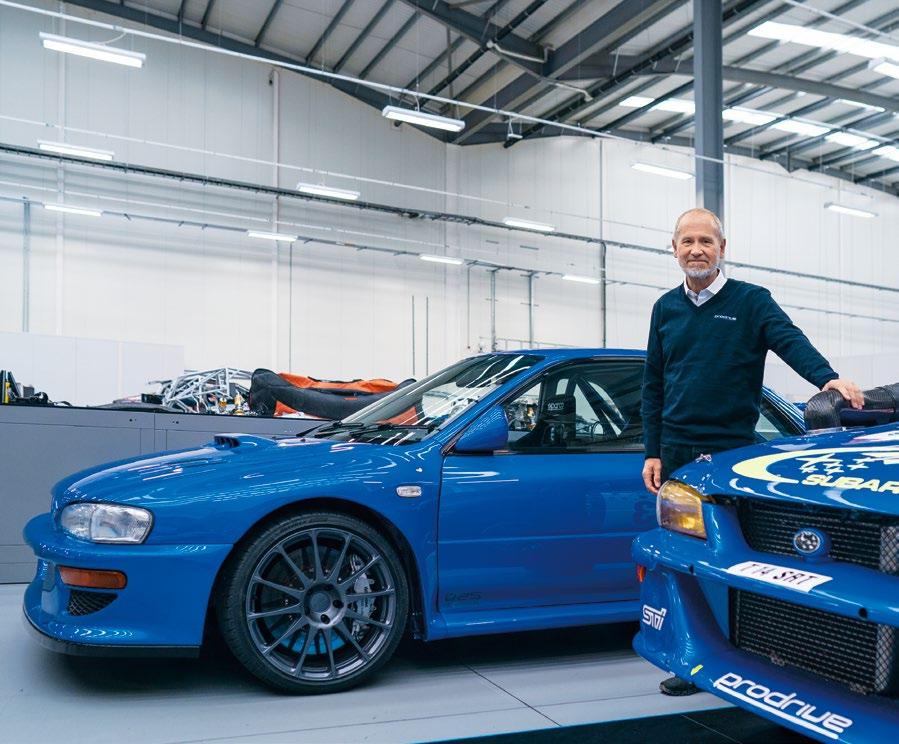
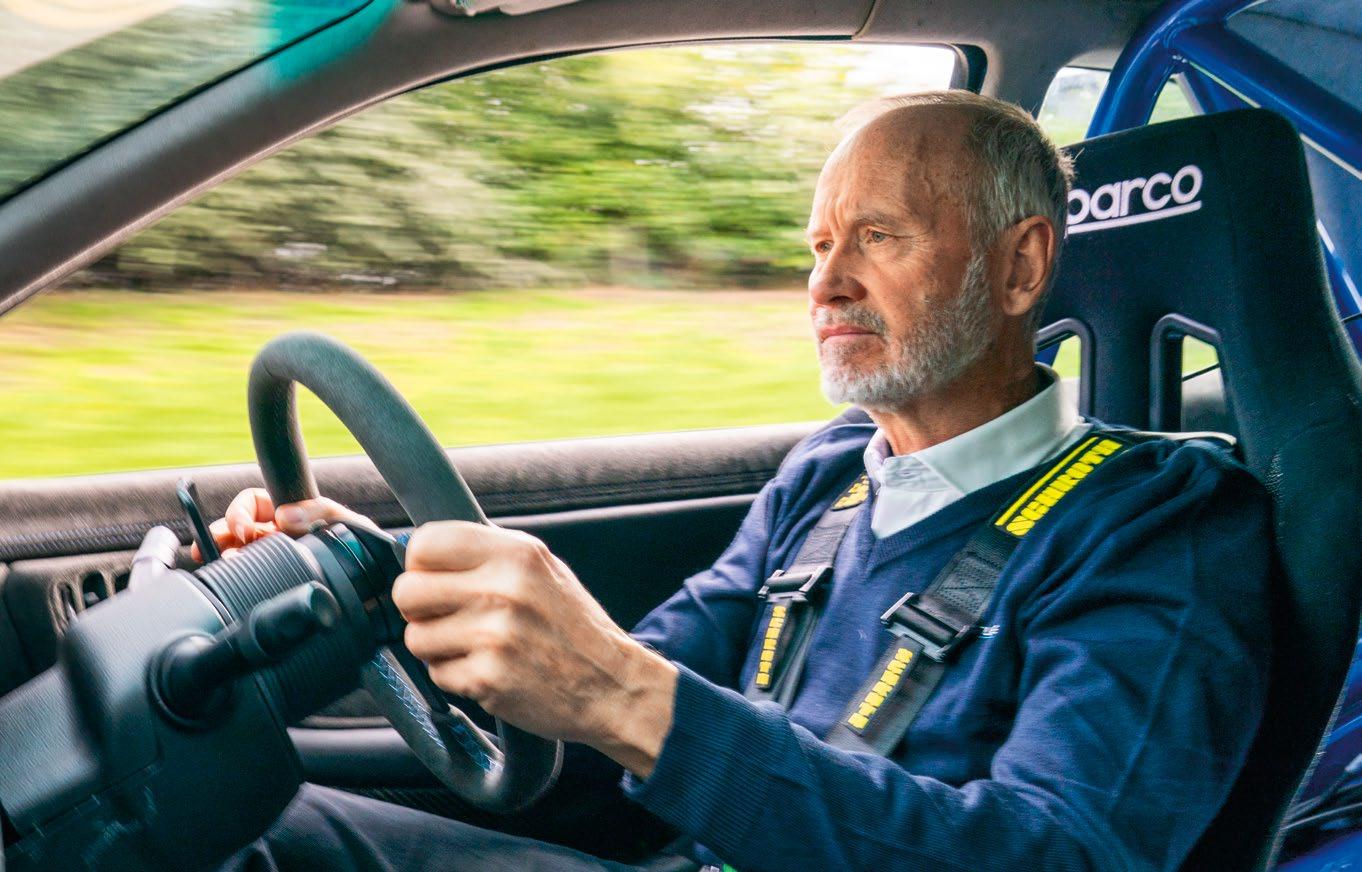




You won’t find a stick shift in a P25, but a six-speed sequential racing gearbox complete with WRC-style paddle shift and launch control. The sort of racing know-how that is second nature to Prodrive, complete with 60 millisecond gear shifts. The 19 inch gunmetal - not gold - wheels are fitted with AP Racing brakes with 380 mm vented discs at the front and 350 mm vented discs at the rear and the car runs on Bilstein dampers and Prodrive’s specific suspension geometry. “The paddle shift really strikes you, it’s very nice,” Lapworth explains proudly. “With a manual ‘box you wouldn’t keep up with it. With the launch control, by the time you’ve initiated it, it’s time to put it into second gear and then almost immediately into third. Manually, you’d
hit the rev limiter in first and second gears and look like an idiot. But do a launch and you’re into third gear when it hands back over to you, which is pretty much how we used to do it in a world rally car.”




So, who did Prodrive have in mind as its target market? “I think we had a better idea of what the car would be than who the customers were,” Lapworth smiles. “But we’re also making sure it’s not just racing drivers or rally drivers. You might not choose it to do the school run, but you could! It’s as drivable as a Subaru would be. You don’t get a limousine ride but it’s surprisingly civilised, as rally cars
always were. It needs to be compliant without reacting to the jumps and bumps. The target is that when you drive it, you go, ‘Wow, this is the closest thing to a world rally car you can get and drive on the road.’” Lapworth concludes: “I can’t divulge customer names, but there are a few that you might expect. I could name half a dozen with a motorsport connection. “So, if you happen to have the requisite half a million pounds burning a hole in your pocket, can you have one? “There may be ways if you have David Richard’s phone number,” Lapworth smiles again. “But pretty much they’re all gone.” A shame…


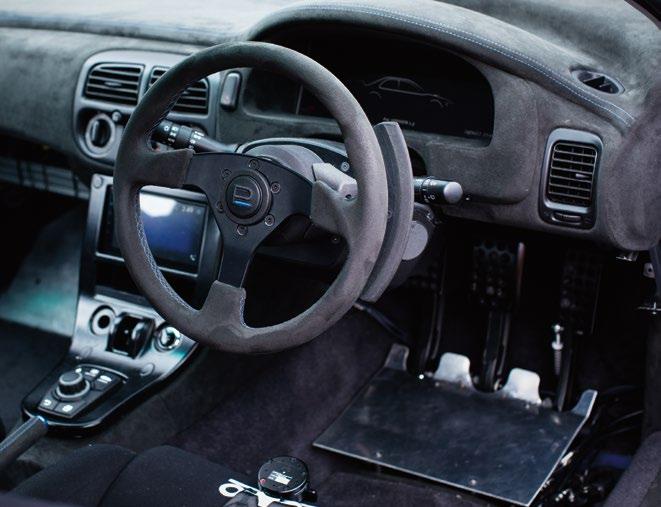


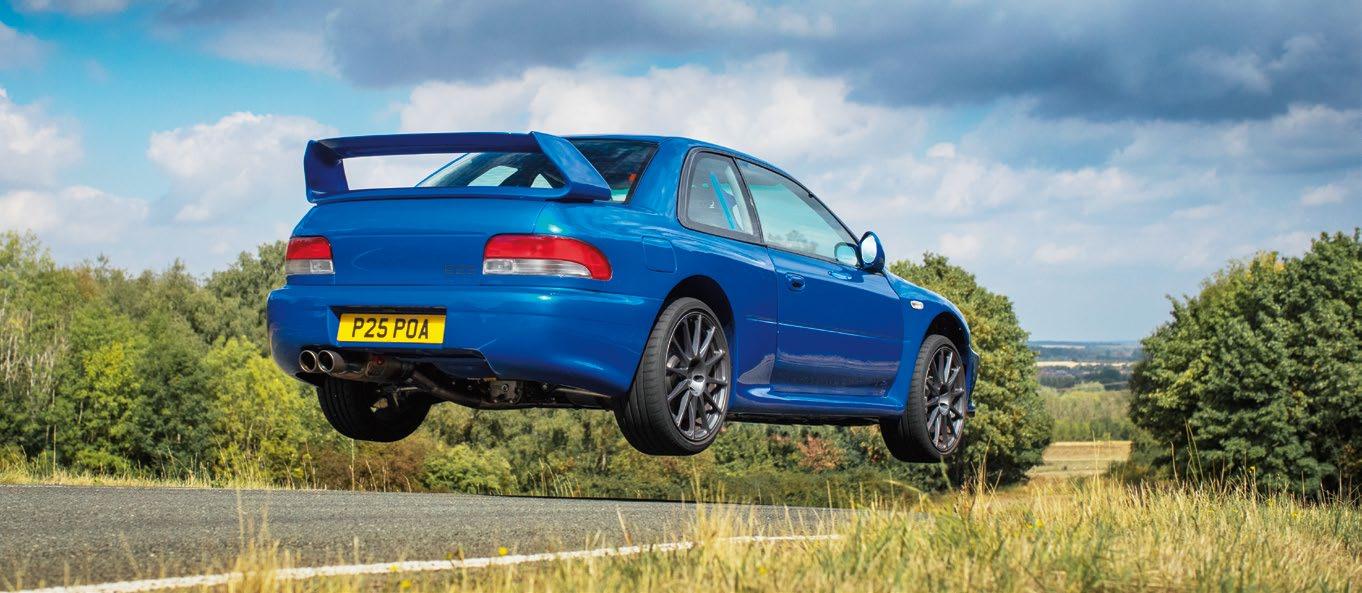
Akrapovič exhaust systems are designed for riders who demand maximum performance from their motorcycles. They feature exceptional production quality, hi-tech materials, increased engine performance and all come with amazing sound and appearance as standard. The change is also visual, as Akrapovič mufflers perfectly fit the exterior line of modern motorcycles and add a clean racing image.


Ducati Scrambler Nightshift + 1.6kW (+ 2.2hp) at 8,600rpm + 3.0Nm at 4,500rpm - 3.8kg (- 55.8%)

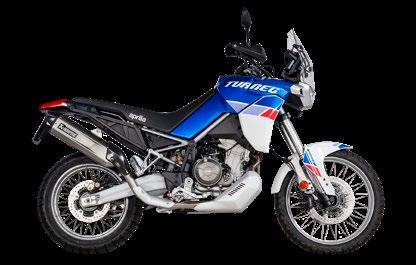

Aprilia Tuareg 660 + 0.9kW (+ 1.2hp) at 4,800rpm + 2.1Nm at 4,800rpm - 1.9kg (- 36.5%)
Yamaha R3 / MT-03 + 0.9kW (+ 1.2hp) at 10,900rpm + 0.5Nm at 9,700rpm - 1.1kg (- 38.8%)


Kawasaki Z650RS + 1.1kW (+ 1.5hp) at 5,300rpm + 1.9Nm at 5,300rpm - 1.7kg (- 29.2%)



Kawasaki Ninja H2 SX + 1.4kW (+ 1.9hp) at 10,100rpm + 1.8Nm at 5,500rpm - 2.2kg (- 28.9%)


Harley-Davidson Pan America 1250
+ 1.3kW (+ 1.7hp) at 2,300rpm + 5.6Nm at 2,700rpm - 0.5kg (- 11.6%)
Because of the world-wide distribution of Akrapovič d.d. products, we make no representation that the products shown comply with the air, noise or other emission laws of your jurisdiction. Hence, please make sure you have all the relevant information before you consider purchasing any of the products. You are welcome to contact our local partner in your country if you have any questions or turn to page 4 and our website at www.akrapovic.com

Check out the latest Akrapovič aftermarket exhaust systems for cars, where only the best materials and exclusive titanium alloys are used. These materials are combined with high technology and exquisite craftsmanship of Akrapovič welders to create a package that separates them from everything else on the market.





Audi RS 3 Sportback / Limousine (8Y)


+ 7.5kW (+ 10.2hp) at 5,450rpm, + 16.3Nm at 2,800rpm, - 10.1kg (- 44.1%),
Titanium, Rear Carbon Fibre Diffuser - High Gloss
BMW M240i (G42)

+ 7.1kW (+ 9.7hp) at 2,450rpm, + 20.5Nm at 2,450rpm, - 4.0kg (- 22.8%), Titanium
Mercedes-AMG GLE 63 S / GLE 63 S Coupé (C293)
+ 6.3kW (+ 8.6hp) at 2,800rpm, + 21.3Nm at 2,800rpm, - 9.2kg (- 34.2%), Titanium
Rear

“I consider myself so lucky,” were the first words from Bobby Rahal during our sit-down on a Beverly Hills rooftop café. “I grew up in that decade of the 1960’s where it was just a magical time, and cars and motorcycles were central to everything young people were interested in.” Sixty years later, it is still a magical time for Bobby Rahal, and from the way he exudes a timeless passion for cars, you’d think he was entering his first decade of car racing — not his fifth. “As I’ve told people over the years, even today I’m a fan first. And oh yeah, I happen to do it for a living, but it was being a fan that got me to where I could do it for a living.” Bobby Rahal, together with TV showman David Letterman and businessman Mike Lanigan, owns a BMW RLL Racing Team. For 14 years they have successfully competed with five teams in INDYCAR and IMSA series in the USA.

If you ever want to watch the glow of the golden age of car racing come to life, just ask Bobby about going to Road America with his father, or his beloved 1972 BMW 2002 tii. “It’s easy for me to get excited about it, if you can’t tell. It’s in my soul. That’s where the passion for the sport came from.” It’s a tricky business, turning your passion into your livelihood. And trickier still to maintain that passion across five-decades in an ever-evolving sport, one that has seen him transition from driver to team owner, and seen the cars themselves evolve from analogue into computerised hybrids. “I don’t ever remember questioning my passion. I had that. That was easy. Because it was deep down. Certainly, there were times when I really asked myself, is this worth it? Am I chasing something real, or is it imagination? Do you think you can do it or not? Every time I asked that question, I said, ‘I think I can.’ I just never gave up. As I tell young people that have come to me over the years, there is no secret. It takes hard work, commitment, perseverance. You’re going to lose races more often than you’re going to win. So, what keeps you going? It’s that belief that you can do it. If you don’t have that belief, you need to find another job.”
Key advice Bobby has given to younger drivers might come across as crude, but it’s the gospel truth, according to the 1986 Indy 500 winner: “Listen to your ass.” As I pose the question of this famous phrase, Bobby responds with a chuckle. “Yeah, I tell that to my drivers when we go to Indy, especially. But it really rings true anywhere. And that is because your ass won’t fool you. In racing, there are two things that kind of rule how you drive. One is your brain and one is your heart. And sometimes your heart writes cheques that your brain can’t cash. ‘I’m going to go through that turn flat out because I know I can.’ And you try to do it and bam, you crash. Now, if you listen to your head, your head would have said ‘there’s no way we can do that.’ But even more importantly if you listen to your ass, you’ve heard the term pucker-factor? Well, if that’s happening, you better listen to it and follow it. Because that will save you.” It’s not always as simple as believing in yourself. A racer needs a team that also believes, and throughout the early
years of his career, and trying to navigate his way into the European racing scene in Formula1, Rahal had his share of difficulties. After finding himself at a low point in 1981, things suddenly became much easier when Jim Trueman came to him and said, if you’re smart, you’ll do everything I say. “Having known Jim for five or six years at that point, I was okay with that. He said, ‘I want to go INDYCAR racing, I want you to drive the car.’ We won races in our first year in INDYCAR racing, got Rookie of the Year, second in the championship. If there was somebody that believed in me, that was willing to put his money behind that and help me build his team, that was the guy.” Along with radiating passion throughout his career, Bobby endured some heart-rending extremes, from the high of winning Indy in 1986 to the low of losing team owner Jim Trueman ten days later to cancer. “If you had written a movie about this situation at Indy where he barely makes it to the race and dies ten days after, everybody says, ‘That doesn’t happen in real life.’ But I’ll never forget there was a team owner Doug Shierson at the time, and years later he said ‘the other 32 of us knew we didn’t have a chance that day. The good lord was going to make sure Jim Trueman won that race.’ Even today I get emotional because it… really hits you.”

Passion, loyalty, conviction — racing summons a lot of emotions for a sport that requires you to shut off the emotional aspect out on the track.
Where does a passionate guy like Bobby draw the line? “I do believe strongly in loyalty and I do believe nothing is ever without issues or without problems. But what I look for in people is their character. That’s who you want to be with. So, when I race, yes, I had those emotional commitments. But in the race car, I tried to be as calculated and cold and emotionless as possible, because it goes back to that heart/ brain/ass combination. In the sense that you have to have your heart in it, but you have to control that. Somebody has to be the adult. If it’s not here (points to head), it’s down here (points to ass). I’ve always had to drive that way. If I was emotional when racing, I felt I would make mistakes. There’s no question I’ve made mistakes times where I’ve tried too hard, or somebody passed me and I’m going to get him back, and maybe end up… not. So that’s why I’ve always said I think emotions are really the enemy. It’s too easy for them to take over.”
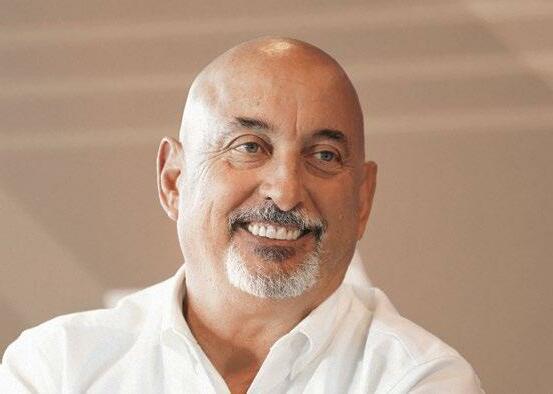
As the cars, computers and digital aspects of racing have evolved, Bobby has also seen the evolution of the demands on the driver. The dynamics of data acquisition have changed the game in many aspects, yet some things stay the same. “When I started INDYCAR racing, it was you, a mechanic and maybe one other guy and that was it. The amount of information that you dealt with was far less than it is today.”
And what exactly is he doing now? He runs RLL Racing in USA, competing with five teams in INDYCAR and IMSA series. They achieved more than 50 victories in over 20 years of racing altogether; with BMW M Team RLL they won the famous Daytona 24 hours race two times in succession in 2019/2020, so Bobby knows what is he talking about racing once and today.








BMW M4 GT3 cars of BMW M Team RLL team are all equipped with Akrapovič exhaust systems. Regardless of his success in his current role, he prefers to compare it with his racing career: “Toward the end of my career is when data
acquisition first started coming in, and ’83, ground effect. It became much more of an engineering experiment, to a large degree, and the driver became part of that engineering aspect. Now it’s much more sophisticated, much more data dependent. And that’s not getting less, that’s increasing. Because now you look at racing companies like ours, we’re hiring software writers. No one in racing even knew what that was 30 years ago. So, it’s becoming more and more sophisticated. It’s a different world.” With technology changing the analogue into a digital experience, what has this done to Bobby’s timehonoured passion rooted in the golden age of car racing? “In the end, it’s still man and machine against man and machine. There’s still that human element. Big time. We haven’t gotten to the point where the human being is being replaced. We are actually asking more of the driver now and we’ve also added all these other areas of information that make that human being even more effective, more successful than he might have been otherwise. Just like a fighter pilot. You look at a World War II fighter plane, you look at a plane today… but ultimately there’s still a guy in there flying it. And that makes the difference.”


He dominated Alpine skiing in the past decade, winning the overall World Cup eight times - in a row! Only Ingemar Stenmark has more victories in the men’s World Cup. Marcel Hirscher is a skiing icon. He retired unexpectedly in 2019 at just 30 years of age and is now pursuing many new goals. He has his own ski brand and continues to live an adrenaline-filled life that includes mountaineering, freeriding and, above all, motorcycling. Everyone knows Hirscher’s love of skiing, but few know that he has been a gifted motorcyclist since his youth. No longer a professional athlete, he mostly avoids journalists, media, and the public nowadays. He welcomed us at the tiny village of Annaberg in Salzburg’s Lammertal, an idyllic setting that he grew up in and decided to return to. He had just come back from his latest vacation - in Slovenia.
You seem to love all kinds of sports. The latest Instagram photos show you rafting on River Soča in Slovenia. It was great! I haven’t done that for a very long time. I used to go there very often with my friends as a child and teenager until I was about 16 or 17. Then my increasing obligations pushed it to the background. But the other day we decided to go there again. It has changed, the infrastructure, new roads, so many tourists, I could hardly believe it. I have so many wonderful memories of this valley and the untouched nature there. I know Soča valley best in Slovenia, Kranjska Gora actually not that well. (laughs)
Despite celebrating the second giant slalom World Cup victory of your career in Kranjska Gora in January 2010? Yeah? Is that so?
Are you interested in your career stats?
No, not at all. In a chat I can tell a lot about my career in general, but not about the individual races, wins or such. I always considered statistics as quite unimportant. Statistics are always the past.
Let’s stay in the past, though. Even as a very young man you were already a keen motorcyclist. Quite unusual when growing up in such a beautiful remote valley, surrounded by nature and mountains, isn’t it?
Absolutely. My father ran a mountain pasture and I always helped. I had enough savings to either buy a horse or a motorcycle. A very difficult decision... Later I realised that I had made the right decision – a trial bike. I started doing trials when I was 11 or 12 and a few years later I switched to motocross. Then three years ago, after finishing my skiing career, I started with enduro.
Were you even allowed to ride all those motorcycle races? As a professional athlete, you have to sign contracts, don’t you? Your compatriot Gerhard Berger once told me that his Ferrari contract prohibited him from skiing. Although he did it anyway...
Skiing is dangerous, too. But yes, you’re right. Several times they tried to ban me from motorcycles in a contract, but I always said, well, in this case it’s over with skiing. Additionally, I must say that motocross was very important and valuable in terms of my fitness.
What fascinated you about motorcycle riding when you were a teenager? When you start the engine, something gets moving. You feel something, it vibrates... You experience new moments, new boundaries with the bike, which you can’t reach on foot.
My father was an amateur motocross rider and bikes parked in the garage were a part of my childhood.
Do you want to start a second career like Luc Alphand for example, or do you do motorcycle races mainly for fun? I want to improve all the time. But a real second career, I don’t think so. I had a lot of fun at the Erzbergrodeo, but I also realised that I was playing in a different league compared to the best there.
In skiing, you have to do all the work yourself to win and succeed, whereas in motorsport you have to rely on your machine. Without the best bike, you can’t win, even if you do have the best riding technique, right? (laughs) Hmm, quite wrong, actually. A ski may look like a very simple piece of equipment, but it’s at least as important for winning as a motorcycle is in motorsports. When it comes down to the hundredths of a second, it’s the material that ultimately decides. In skiing, too.
But surely, it’s your legs and mind that make the difference in skiing in the end? No, not overwhelmingly. Let’s say fifty-fifty – half for the material, half for the skier. I will never win a World Championship motocross race, even with the best bike, while Antonio Cairoli can occasionally win with a poor bike. It’s rather different in skiing. If your equipment and set-up are poor, you crash out at the third gate, no matter how good you are.
Seems incredible that you can do it all! Skiing, training, winning and still having a family and motocross as a hobby. A day only has 24 hours, but for you it should have at least 40!
Not quite. I used to be proud when people told me I was like a machine. But now I’d like to distance myself from that. I’m glad I’m not a machine, I’m just a human being, I’m Marcel. It was already a very intense time, I had to be extremely focused, there was only work. Especially during winter. The more my active career recedes into the past, the more I realise how intense it all was. If you’re a place

I’m only 33, but sometimes I feel very old. The price for success was very, very high.
skier, sometimes finishing fifth, then maybe on a podium, then fifth again, it may still be okay. But if you always have to be at the press conferences, constantly face anti-doping controls, the ceremonies around the podium... You never get to dinner before 10pm. And the next day it starts at 5:30am again. As long as you’re there, it’s a merry-go-round that never stops. I’m only 33, but sometimes I feel very old. The price for success was very, very high.
How aware were you of such facts during your career? Did you sometimes just want to quit?
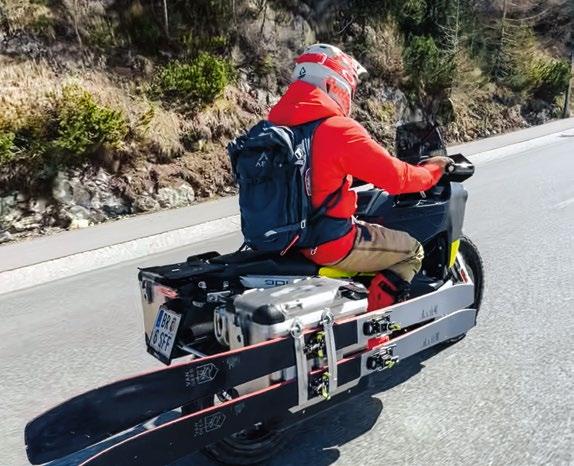




Very! And very often! And then the next day comes and you say to yourself, I’m in the middle of my career now and with a little luck I can make the impossible possible. That was always the key, the four overall wins I already had. If I had stopped or taken a year’s break, then the fifth overall victory in a row wouldn’t happen. That’s why I kept going.
Were all these victories the goal for you or rather the path?
(very long thought) I’d say both. The bad thing was that after winning, when you get the flowers and are attending the victory ceremony, in your mind you are already thinking about tomorrow. You can’t enjoy it, because from the moment you cross the finish line, everything is already over. That feeling is crazy. But if I had been able to celebrate my victories in a different way, maybe I would never have won
When you start the engine, something gets moving. You feel something, it vibrates... You experience new moments, new boundaries with the bike, which you can’t reach on foot.
so many races. And another thing that’s always at the back of your mind is that you’re always being chased.
Even when one is as dominant as you over such a long period?
Yes, it happens so quickly. The day you think you are the best is the day you’ve lost. It always goes on and on and on... Yes, today I won by three seconds, but tomorrow is a new day.

How does someone like Marcel Hirscher learn to lose in the first place? You were always at the top, always the best, and then you quit professional skiing at your zenith.
I was always aware that somewhere there is a faster skier than me. He may live somewhere else, play football or work for Akrapovič and can ski better than I do. But he has never skied. After Hermann Maier, the question was would there be another Austrian like him. Then I came and someone else will come after me. We already have a new star - the Swiss Marco Odermatt. I really have a lot of confidence in him. He will also win everything. In life, you should never be complacent, there is always someone better, more amazing, stronger...
We are sitting next door to where Van Deer skis are manufactured. Where did the idea to produce your own brand come from?
Towards the end of my career, the desire to offer racing skis for everyone had already matured in my head. Unfortunately, many commercial products are very poor. It’s about the money, margins, quantity... Dominic Tritscher and I wanted to bring a cool, honest product to the market, which would make people say: “Wow, I’ve never felt anything like this, never skied like that before.” I wanted to bring such a feeling to ordinary skiers. I
tested at least a thousand pairs of skis, so the know-how was there. And the best people from my skiing career were all there and believed in this idea. So, right now I’m probably the most renowned test rider for a product without compromise. We are trying to create a masterpiece with Van Deer and everyone on the team is pulling in the same direction.
Not only amateur skiers, Henrik Kristoffersen was immediately enthusiastic as well. Your biggest rival at the time now uses your equipment. How is something like that possible? When Henrik called me, I thought he wanted to go motorcycling together. [Author’s note: Kristoffersen is a passionate motocross and enduro rider.] But he asked me how things were with Van Deer now. I thought he was joking, but he said he had tested the product and was surprisingly pleased and happy with how it held up on the snow. Besides, practically my whole former team works for him, my father, my service guy. Now all of us, me included, are trying to make sure Kristoffersen gets the best support. He’s certainly capable of winning the overall World Cup.
It’s also an interesting role to cheer along as a team boss from way down in the finish area. How different is that to skiing?
No idea. After finishing my career, I’ve never attended a competition, except the one time at Kitzbühel as a course-skier. I was not interested. The journalists, the media, the photographers...
You are known to place great importance on protecting your private life. We know that you have a daughter and a son and that you are divorced and
not much else. On the other hand, you live in a small village where everyone knows everyone anyway. Why is it so important to you even now, after finishing your active career, to keep your family out of the public eye?
(long pause) Everyone wants to separate their private and public lives, don’t they? My ex-wife Laura and I just wanted to be able to have dinner, go shopping, go to the movies in peace. I never accepted the fact that the media didn’t want to respect this boundary. That also has something to do with my upbringing, I think. Mutual trust must always be there, and with the media, once I became known, that was over very quickly. I can always stand by the truth, but when people lie, it’s over. Then the media won’t get anything more from me.
You have two little kids. Did your life change after becoming a father?
(laughs) Definitely. The centre of life shifts to the children. I was very deep into sports and now I often ask myself whether it really was all that important. Yes, it was at that moment, because it was about success, but now it’s about other things. The health and well-being of my family and children have priority now. I will not tell my children to become professional athletes. I will support them if they decide to do so, but I don’t really want them to become professionals.
What’s your plan for the next 15 to 20 years?
To rest, to succeed in my projects, to experience joy and enjoy a good life.
Or perhaps win the Dakar eight times in a row on an Enduro-bike? (laughs) No, that will definitely not happen!
In life, you should never be complacent, there is always someone better, more amazing, stronger...
Marcel Hirscher: Druga kariera? Raje ne ...
Marcel Hirscher je smučarska ikona; kar osemkrat zapored je zmagal v skupnem seštevku svetovnega pokala v alpskem smučanju. Leta 2019 se je pri 30 letih presenetljivo upokojil in zdaj sledi številnim novim ciljem. Ima lastno blagovno znamko smuči Van Deer in še naprej živi adrenalinsko življenje, ki vključuje alpinizem, prosto smučanje in motošport. Čeprav se večinoma izogiba novinarjem, medijem in javnosti, nas je kmalu po vrnitvi z raftinga v dolini Soče v Sloveniji sprejel v domači vasi Annaberg v Lammertalu. Motokros je bil za njegove smučarske treninge zelo pomemben in dragocen. »Ko zaženeš motor, se nekaj premakne. Nekaj začutiš, zavibrira ... Na motorju doživiš nove trenutke, nove meje, ki jih peš ne dosežeš,« je med drugim dejal 33-letni Marcel. O novi karieri vendarle ne razmišlja: »Vedno sem si želel postati boljši. Ampak ne verjamem v pravo drugo kariero. Na Erzbergrodeu sem se zelo zabaval, vendar sem se tudi zavedal, da sem med najboljšimi motociklističnimi dirkači le drugoligaš.«
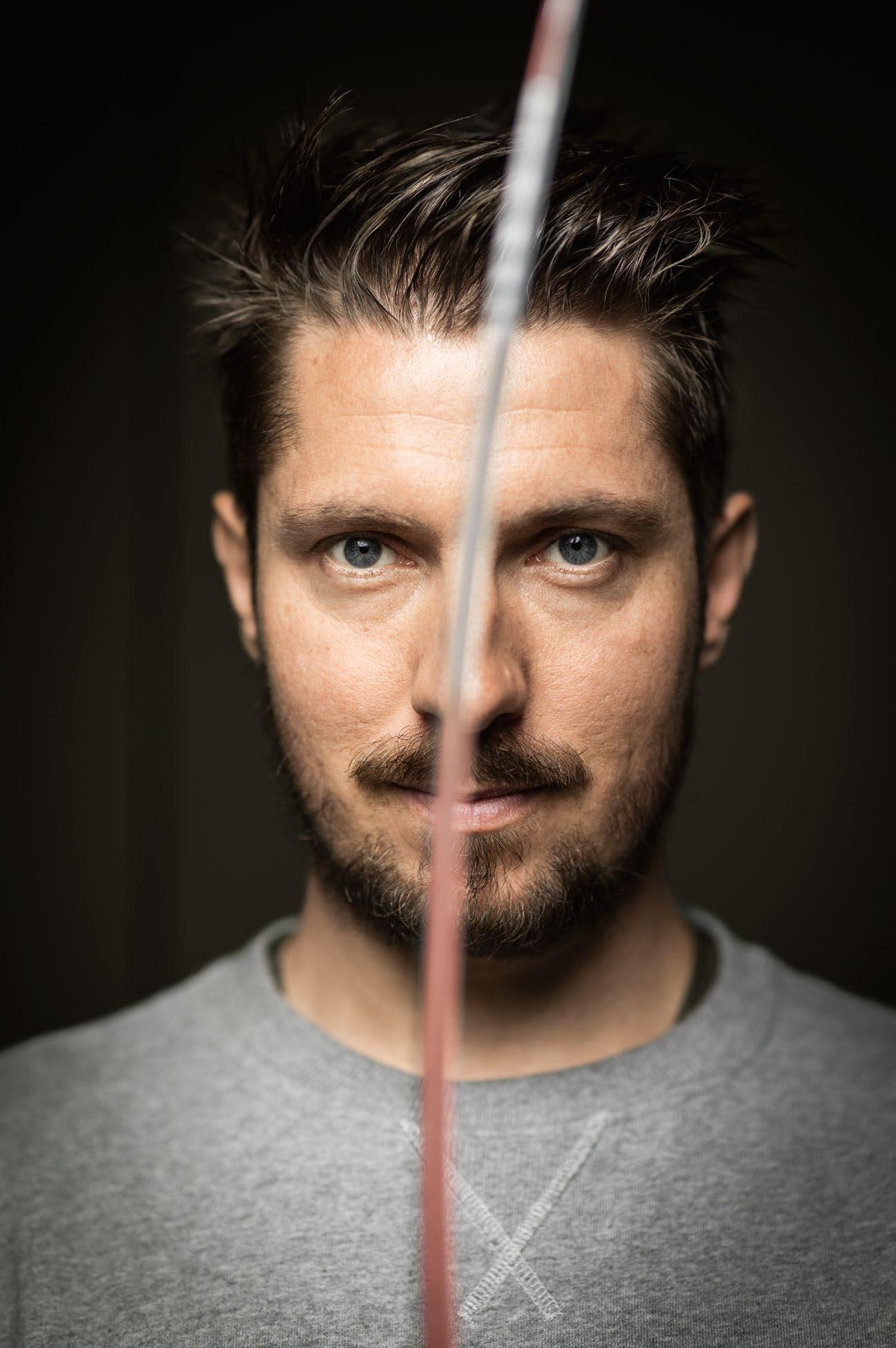
Love of design and cigars gave birth to a young Slovenian company and its first product - Pharos. This cigar rest, named after the Lighthouse of Alexandria, one of the seven wonders of the ancient world, was created with the aim of proudly showcasing the cigars while the smokers fully immerse themselves in their special moment of the day and enjoy their leisure time to the utmost. Made of high-quality materials and with immaculate surface treatment, the cigar rest features an engraving of the Alestimo brand signature on the bottom, finished with a specially prepared shade of black inside the logo. Rounding up the exquisite nature of the experience and preventing damage to its bottom or the surface it is placed upon, Pharos comes in three versions, all equipped with an anti-slip rubber mat. The photo features Pharos King in 24k gold.

alestimo.com/pharos-page/ 40
Felt Bicycles’ IA 2.0 aims for the very top in triathlon racing. Hi-tech carbon, aerodynamic, speedy and trendy - no surprises there as company founder Jim Felt used to be an MX rider. But triathlon racing is brutal. Imagine sweating and suffering in the heat and humidity across miles of twisting, undulating, and scorching roads. Your muscles contracting in anguish, your lungs screaming as they burn and stoke your inner fire of perseverance. IA 2.0 will make sure you overtake the rest of the pack in a blur of speed, without having to look back as well as knowing that they will never catch you. Cross the finish line, take the win and smash your personal best in front of a cheering crowd of racing fanatics. Revel in your exhaustion, experience the euphoria of your sacrifice, and relish the pride of having gone faster than you’ve ever dreamt possible. To exceed your goals in the unique crucible of triathlon, it is not enough just to be fast. You have to be crazy fast.
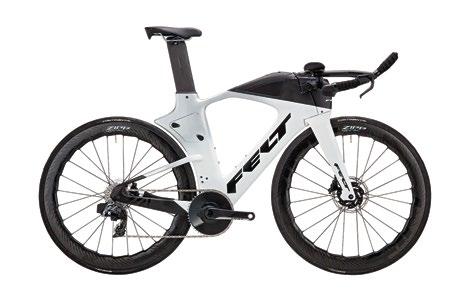
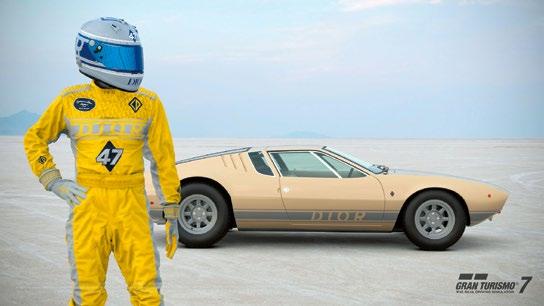
French couture fashion house Dior has collaborated with the iconic racing car game Gran Turismo 7, producing a unique in-game experience that combines the thrill of racing with the pull of glamour. The starting point were the glamourous adverts of Dior perfumes between the ‘60s and the ‘80s. Yellow is iconic, the design team decided, and created a yellow racing suit with ‘Diorizon’ boots and gloves. The complete set includes the virtual version of a vintage car - a cream-coloured De Tomaso Mangusta.
playstation.com
Meet the most stylish sneaker of the day, the Nike “Air Force 1” by Virgil Abloh. Creating this beautiful sports accessory required the collaboration of Louis Vuitton and Nike. Crafted in Maison’s atelier in Fiesso d’Artico, Italy (outside of a Nike factory for the first time), the Louis Vuitton “Air Force 1” fuses the sneaker’s original codes with the finest materials and insignia of the Maison. Originally designed by Nike in 1982, the two iconic brands have joined hands to create the most authentic high-end sneaker. There are 47 Air Force 1 editions.

eu.louisvuitton.com
Rolling Stones fan? We have something for you. V-MODA, the go-to audio brand for DJs, has partnered with The Rolling Stones to release a new line of headphones inspired by the band’s lyrics, logo artwork and albums. Showcase the style and swagger of the band with three exclusive designs, titled ’Classic Licks,’ ’No Filter’ and ’Tattoo You.’ These custom V-MODA Crossfade 2 Wireless headphones are equally appropriate for both fans of the band and musicians looking to jam out. They are intended for pure analogue wired as well as wireless listening, and are becoming a favourite amongst professional musicians worldwide. Being able to pair with multiple devices simultaneously (such as your phone and laptop) they’re great for casual listening, too.
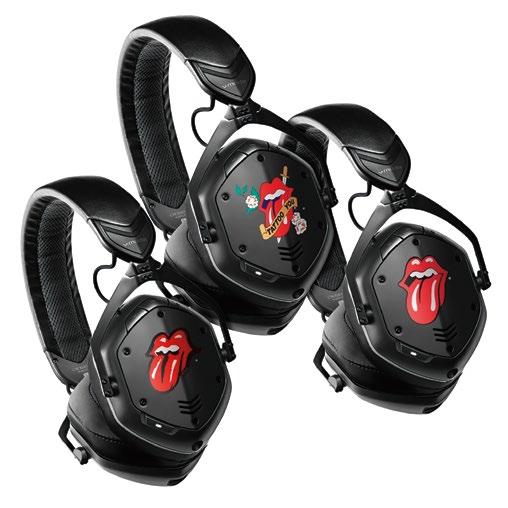
v-moda.com
Ultimate Toys for Men (New Edition) by Michael Gormann is the definitive catalogue for any discerning gentleman. Richly illustrated and meticulously curated, the publication contains the best bespoke and luxury products and premium experiences around the globe, anchored in the belief that only top quality is true value for money. Whether a sports car or a mega yacht, a weekender bag or a boutique hotel, editor Michael Gormann selects the best the world can offer to the modern cosmopolitan man. Age is irrelevant; the boys’ toys just get bigger or more exclusive. The much-anticipated sequel to Ultimate Toys for Men, this updated edition includes a dazzling array of slick new gadgets for guys, handmade beauties, customisable accessories, and all manner of luxuries to rent, buy and experience. Special features cover the ‘Best of Mallorca,’ ‘Best of London,’ and the finest collector’s items.

363.6 km/h, the highest officially measured speed of a MotoGP motorcycle so far, was reached by Jorge Martín (Prima Pramac Racing) during this year’s Italian GP at Mugello in Italy, on a Ducati fitted with an Akrapovič exhaust system. This is just one of the milestones Akrapovič passed during its two decades of presence in the premiere class thanks to the Racing R&D team, led by Slavko Alojz Trstenjak.
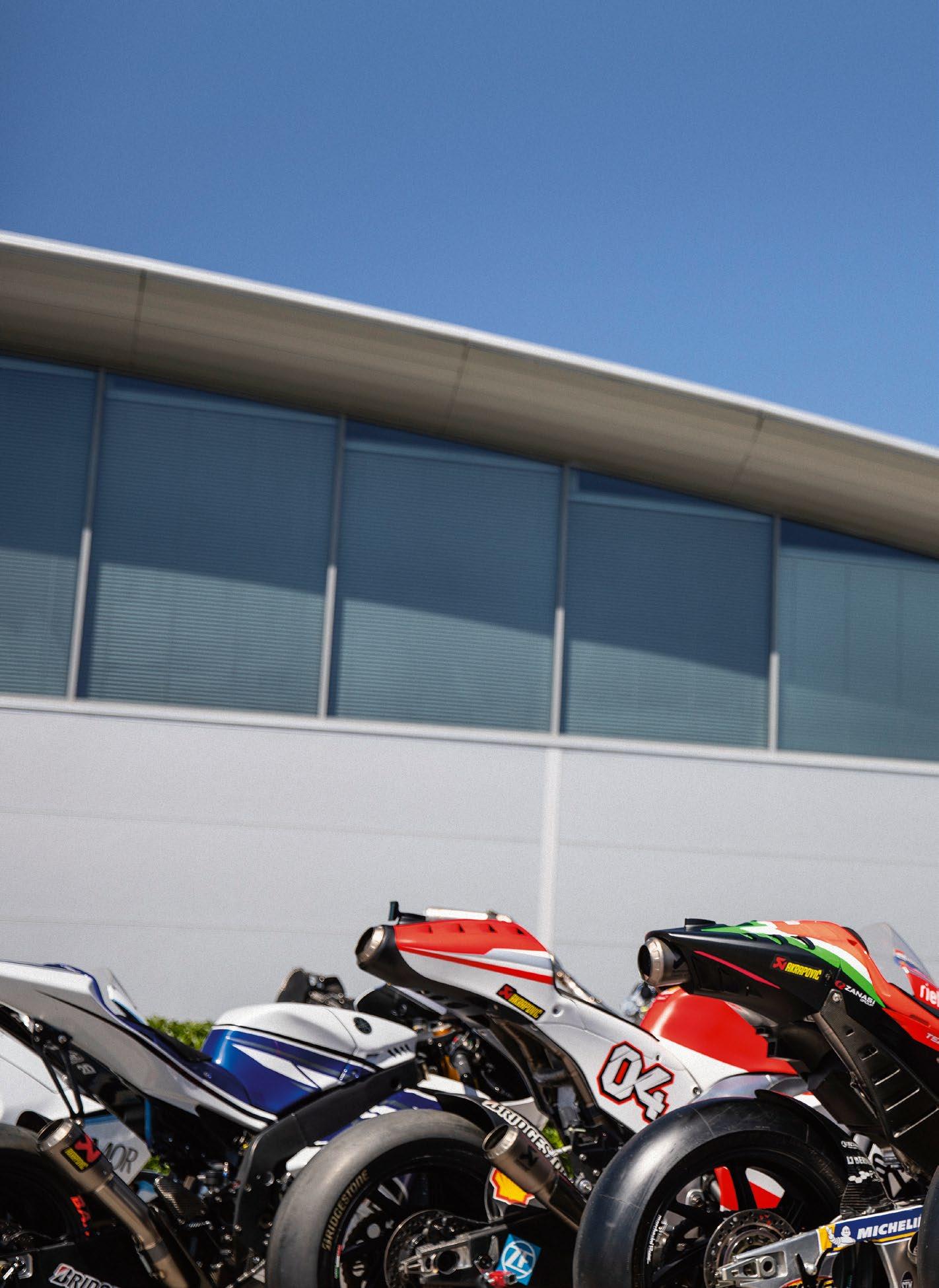
 photography chili films, Polarity Photo, Yamaha, Bor Dobrin
photography chili films, Polarity Photo, Yamaha, Bor Dobrin
The company’s 2002 entry into the MotoGP class made perfect sense, seeing that it happened when FIM regulations introduced four-stroke power units alongside two-stroke 500cc ones, as the Slovenian performance specialist had a lot of experience with the former four-stroke power in the top flights of motorcycle racing, namely the Superbike class. The fact that all Japanese and one Italian works team cooperated with Akrapovič in the World Superbike Championship (WorldSBK) in 1999, speaks volumes about the knowledge and experience the company from Ivančna Gorica already had with four-stroke power units way back then. But, even before that, Akrapovič had been working with numerous teams in the highly competitive German Pro Superbike series. Akrapovič has racing in its DNA, as company founder and owner Igor Akrapovič is a former racer himself. It is therefore
one was won by a motorcycle not fitted with an Akrapovič exhaust system. As far into the season as after the Australian Grand Prix, there were still three riders with Akrapovič-equipped motorcycles among the top-four with theoretical chances of becoming world champion in the premiere class this year. All-in-all, three riders have won the overall world championship title in the premiere class of motorcycle road racing so far while using Slovenian exhausts: Jorge Lorenzo (Yamaha Factory Racing / Movistar Yamaha MotoGP) in 2012 and 2015, Joan Mir (Team Suzuki Ecstar) in 2020 and Fabio Quartararo (Monster Energy Yamaha MotoGP) in 2021. After winning the first MotoGP World Champion title for Akrapovič, Lorenzo also gave the Slovenian exhaust maker its 100th overall world championship title three years later. The 2012 and last year’s season markedly stand out for another reason – world
champions in the MotoGP, Moto2 and Moto3 classes all sported Akrapovič exhaust systems on their motorcycles.

But success has never been taken for granted; each and every exhaust system, itself just one of the many components of a racing motorcycle, requires a lot of effort and energy. For some years now, exhaust systems for the teams have been prepared anew every year before the start of the season, with at least one or two major updates alongside a bunch of minor changes – from 10 to 30 – over the course of their use. Akrapovič is not only a producer of exhaust systems for MotoGP motorcycles, but also a development partner of the teams that cooperate with Akrapovič racing engineers, led by Slavko Alojz Trstenjak, to further improve their

not surprising that the company first focused on development and production of exhaust systems for racing motorcycles. If you looked at the company’s CV in 2002, it would have read ‘more than 10 years of experience with four-stroke power units’ and statistics at the end of the 2002 MotoGP season would record that Akrapovič exhaust systems were fitted to Aprilia and Kawasaki works teams’ motorcycles. But that’s just the beginning of the story.
The company’s progress in MotoGP can be best appreciated by numbers: in 2010 Akrapovič exhaust systems were used by around 12% of MotoGP riders on the grid, in 2022 this number is 75 (wild card entries not included). Meanwhile, of the first eighteen races of this season, only
 2022 MotoGP factory teams using Akrapovič exhausts: Red Bull KTM Factory Racing, Team Suzuki Ecstar, Ducati Lenovo Team and Monster Energy Yamaha MotoGP.
2022 KTM RC16
2022 MotoGP factory teams using Akrapovič exhausts: Red Bull KTM Factory Racing, Team Suzuki Ecstar, Ducati Lenovo Team and Monster Energy Yamaha MotoGP.
2022 KTM RC16
MotoGP bikes with ever-better exhausts. A great example of this cooperation is the ‘double’ Akrapovič exhaust system on the Suzuki GSX-RR, which helped Joan Mir become the 2020 MotoGP World Champion.



Akrapovič racing department, which five years ago developed a complete ready-to-race exhaust system for a MotoGP racing motorcycle that weighed in at under two kilograms, has been the go-to address for questions about MotoGP exhaust system development in the last twenty years. Whereas the first decade of the 21st century saw exhaust prototypes being constructed on bikes, with designs, in some cases, arriving by post from other continents, the middle of the second decade saw a dramatic shift in the approach to exhaust system development; exhausts are now designed exclusively by computer and building them by working on the

bike is only possible in the prototyping phase for testing and specification requirements; the final product is always designed in a 3D environment. This shift came due to the requirements for work optimisation, the use of space on the bikes and precision craftsmanship.
Exhaust system development in MotoGP moreover made exhausts smaller and lighter through the years, also due to increasingly thinner tubes. Today, exhaust systems in the premiere class are active, i.e. equipped with built-in valves to control and regulate the effect of engine braking. However, the use of valves increased the temperatures inside the exhaust systems to such a degree that Akrapovič began using special coatings to protect the titanium tubes from oxidation and further improve their temperature resistance. For additional heat
protection of the components surrounding the exhaust system, the company has also developed a special type of insulation that prevents heat radiating from the scorching exhaust tubes.
Even occasional MotoGP race spectators will probably have noticed that exhaust systems fitted onto MotoGP motorcycles have replaced their mufflers with megaphones. Coming as a consequence of an increase in the allowed loudness from 120dB to 130dB at 5,500rpms, this change was just one of the turning points in various areas of exhaust development at Akrapovič. The changes in exhaust system development, the new know-how, new equipment (including the in-house titanium foundry where very complex parts are made) and materials, also required fresh technical solutions
and made continuous training of engineering staff a crucial requirement.
Akrapovič’s racing department has more than two decades of experience with various MotoGP power units, ranging from the Aprilia 3 cylinder, Kawasaki in-line 4, KTM V4, Honda V5 to today’s V4 and in-line 4-cylinder engines. Although the 2022 season is not finished, company engineers have already begun thinking about the future. The sound coming from the Racing R&D department’s dynamometer, where, behind carefully closed doors, the visiting team’s engineers and Akrapovič technicians will be testing exhaust systems solutions for the upcoming season, will thus soon resonate in my office again. Then I’ll be able to turn off my radio.
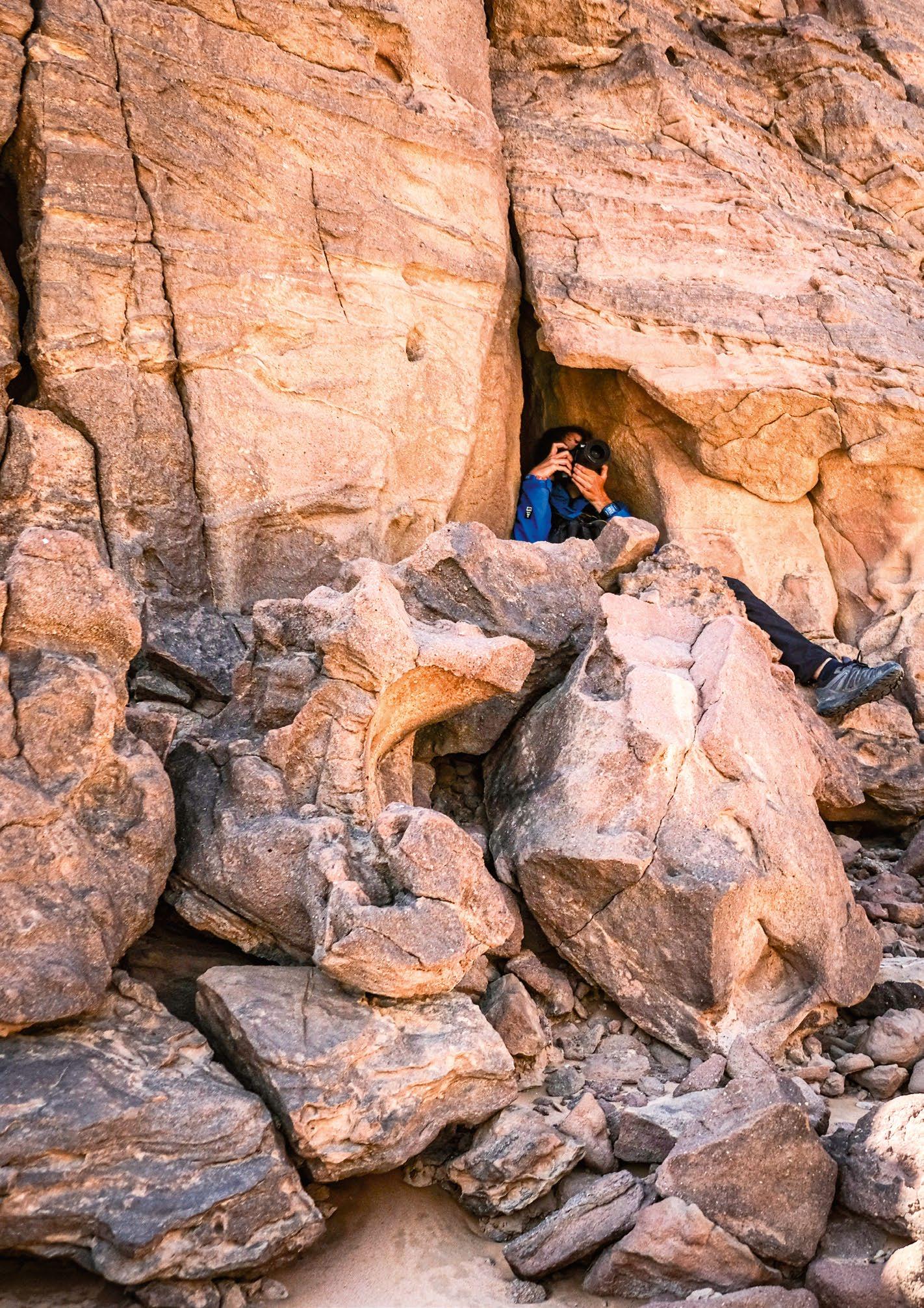
Dakar Rally is a race not only for competitors, but also for the professionals that are there to narrate the epic adventures of those taking part.
Photographers and journalists live themselves a race, made by sleep deprivation, quick bites of food and a car as an office. A combination of factors that makes it a tough adventure for strong hearts, as well as a lifetime experience.
 by Federico Tondelli
by Federico Tondelli
With almost 450 crews competing in the 2022 edition, the day becomes very short when you need to find as many stories as you can, chasing any romantic sides of the competition.


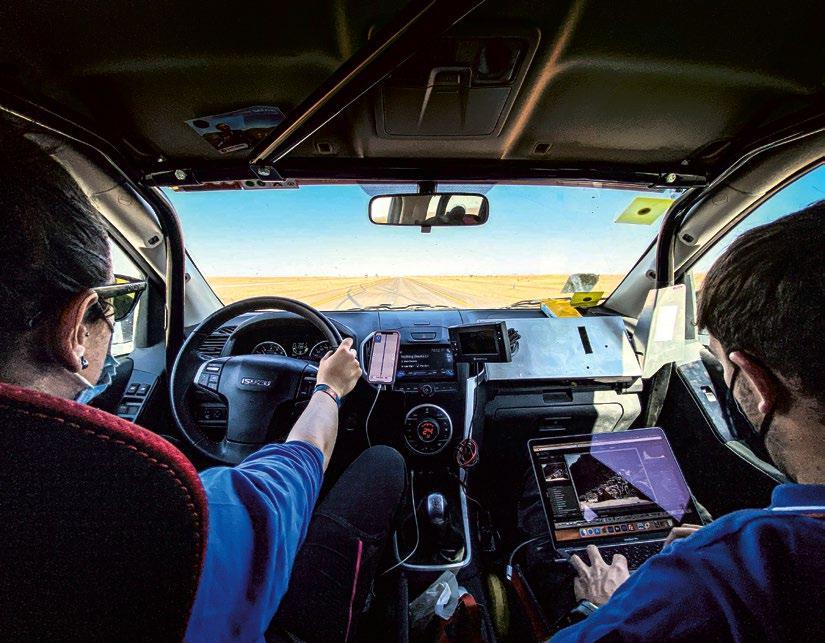

Assuming that after the day (or night) before, you made it to the bivouac, the alarm clock rings at 4:00am, you wrap the sleeping bag, deflate the mattress, fold the tent and make sure everything fits in a single suitcase, a Tetris that becomes harder (and heavier thanks to the sand you accumulate in the cracks of the luggage here and there) day after day. At the canteen you grab the bag with breakfast and get in the car, following the route reserved for assistance vehicles. There are from 500 to 800 km between one bivouac and the next and you have to arrive before the racers finish the stage, because that is the moment when the encampment comes to life and the word of mouth of stories and the odd curiosities begin. With almost 450 crews taking part in the 2022 edition, the day becomes very short when you need to find as many stories as you can, chasing any romantic sides of the competition. Logistics for the event is not easy either, the bivouac is sometimes more than two kilometres in length and walking back and forth under the mid-afternoon Saudi sun is already a pretty challenging adventure.
Photographers, on the other hand, are hunters, always on the trail. Their GPS points are communicated at the very end, because they are on the race trail and are therefore kept secret for as long as possible. They arrive before the drivers, so they don’t know what route they will take and they need to be quick to read the trails, guess the routing and find the most scenic spots for the best shot. Sometimes leaving early is not enough,
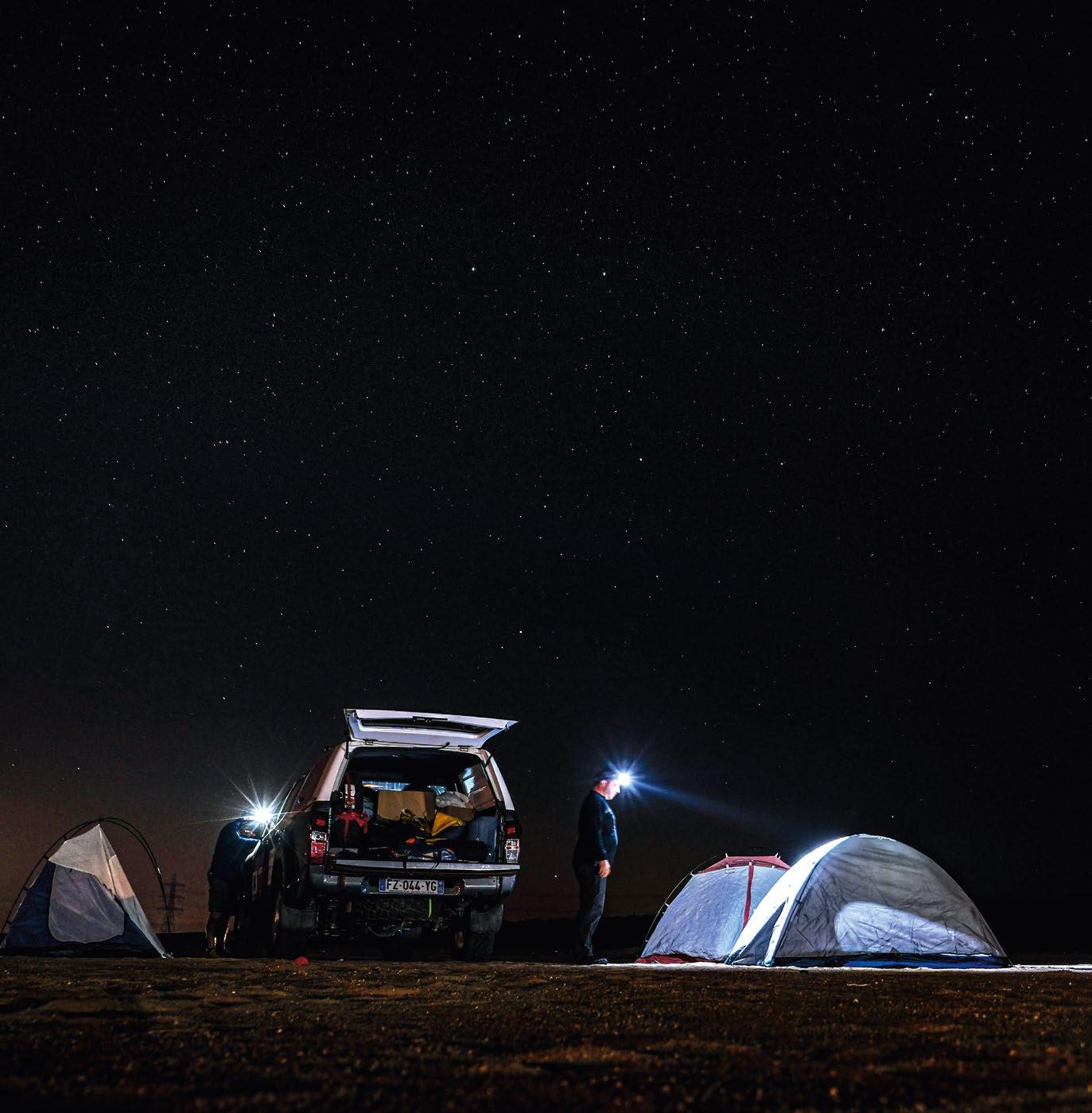
and therefore they do not pass at all by the bivouac, after the stage they go directly to the next day’s point. While one drives, the others work on the photos, to send them as soon as possible. The breakfast that already works as lunch, at the end becomes dinner as well, but the emotion of sleeping under a sky full of stars is priceless. Of course, it’s cold. “Go in the desert, you’ll feel that heat.” But no, not really. The first week of this year’s edition temperatures never rose above 8 degrees during the day, let alone at night. Only in the last stages, those closest to the Red Sea, the thermometer reached milder centigrade, around 18/20 °C.


The terrain is so amazing that it’s not that difficult to frame a good shot from short distance, with the riders frequently playing in front of their lenses in the search of that perfect image that would allow them to increase their followers on Instagram (and


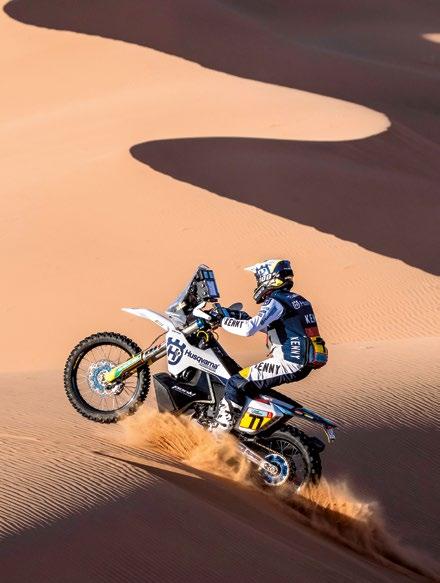
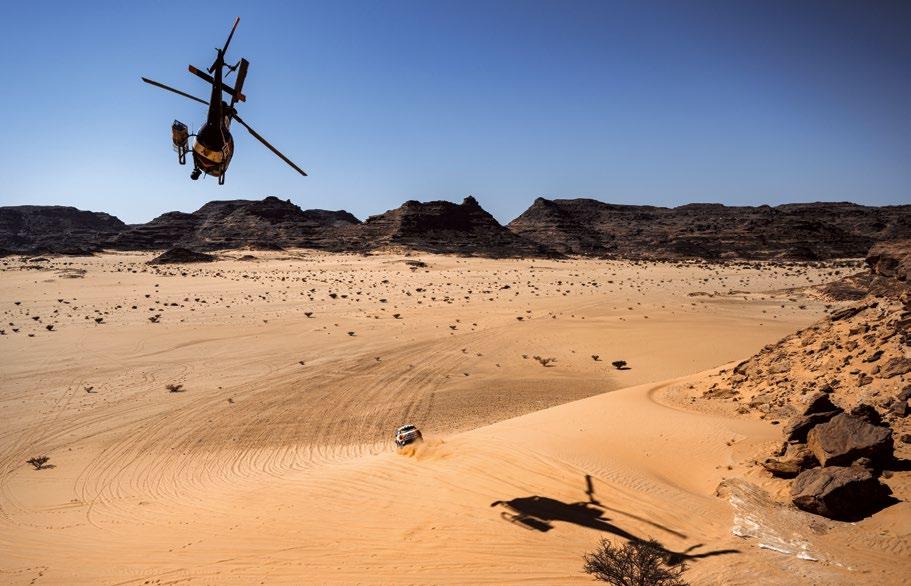
please their sponsors). But getting a perfect shot for a photographer takes a lot more effort, and astonishing landscapes help, but don’t give anything for free: they have to guess the line, spot a potential place and get to it! They climb rocks until the top of the red hill to get the trails, or crawl themselves into a small cave to get that scenery frame, or make their way to the top of a sand dune to freeze the spin of a wheel. Sand is the nemesis of equipment, and a good part of the night must be devoted to cleaning and dusting. Not in the best conditions though: the night in the desert is very dark and the only help comes from a headlamp fixed on their forehead.
Some of the luckiest (or of the best) get a ticket for a helicopter flight above the heads of the competitors. The organisation has more than a dozen choppers taking off every morning, some of them are support or medical wings, but others are equipped to transport one or

more photographers. Secured to the cabin with a harness, their bodies leaning out of the door and their long lenses (usually 500 mm or 600 mm) looking more like a sniper, than a photographer at a sporting event, this is one of the most prized positions for any photographer at the Dakar. The pilots are racers themselves, performing manoeuvres that strain the laws of physics, making the helicopter dance above the car’s roof, which is only a few inches beneath the skids.
Dakar Rally is the race of the races: 13 contests one after the other that build up the whole competition. The first one is the preparation, because getting to the starting stage is already a victory itself. Then you have the other 12 stages, which are a mixer: drive, shoot, write, eat, repeat. Not only the riders, but journalists, photographers, technicians and workers as well. The Dakar is a race for everybody, racers and non-racers.

People are funny: in winter we flock en masse to the mountains to scurry down the snowy slopes and in summer we take to the coast in airconditioned steel buckets. But wouldn‘t it be wiser to migrate like birds to warmer places in winter and retreat to the fresh embrace of the mountains in summer? Ladies and gentlemen, I welcome you to a spectacular corner of the eastern Alps, as experienced atop one of the best machines to tackle mountain roads.
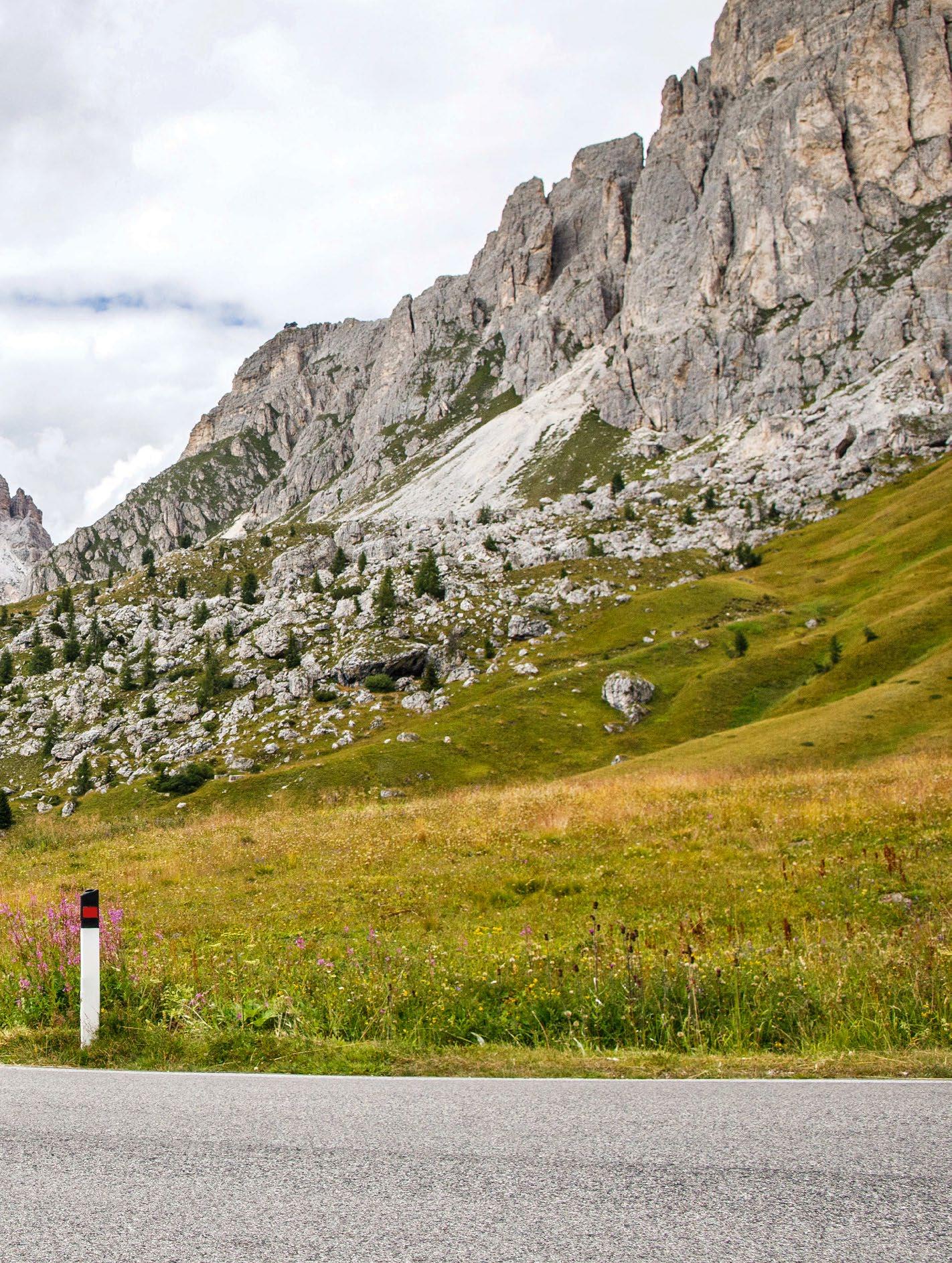
I took the A10 autobahn, which snakes from Villach towards Salzburg at least twenty times, either on the way to Mattighofen to pick up test KTM bikes, to Teutschenthal for the Motocross World Championship races, to Munich, the starting point of our motorcycle tours in the Alps... But always on the motorway. Obviously, one cannot take the slow roads when towing a trailer with eight motorcycles. But this time round there was only one bike involved and, crucially, beneath my derrière. A BMW R 1250 GS in the lavishly equipped Triple Black version, with extra protection bars and a SlipOn Line exhaust, both provided by Akrapovič. I dare say I was on one of the best machines for the journey I planned to undertake. But more about that later on.
Up the valley and across the ski slopes
Not buying the motorway toll sticker paid off as soon as I joined Route 99 at Spittal an der Drau near Porcia Castle, one of the most important Renaissance castles in Austria. A 40-kilometre stretch of this pleasant road winds parallel to the motorway which soars above the valley on tall columns. Lovers of automobile history can stop at the first private Porsche museum, located in Gmünd, to where the company retreated to escape bombing during WWII. It was there that the legendary 356 was born, alongside other wonderful road, racing and military vehicles and even a Porsche tractor. At Mühlbach, where the highway disappears into a tunnel, the 99 passes over the Katschberg ski slopes and, a little later, Obertauern. Here the road is wide, with long bends. Two Ducatis zoomed past, but I cared not; well actually, that’s not true, I was itching to open the throttle, but decided not to, though not out of fear that
the GS couldn’t match the Hyperstrada and the Monster. The Bavarian rides like a charm. Select the ‘dynamic’ mode and its electronically adjustable suspension keeps the motorcycle stable well beyond the limits of sport-touring riding.
An idyllic Bavarian house that produces and stores hydrogen
With the majority of Southern Europe reeling under a prolonged drought at the time, the dark green forests and meadows around here remain copiously watered. As I turn westwards towards Bischofshofen the next day, I ponder about the abundance that has been bestowed on those living here. The road to Saalfelden am Steinernen Meer is fantastic; dynamic and flowing through the valley next to a stream at first and extremely picturesque in a wide valley surrounded by rocky peaks later on. I reach south Bavaria and the roads feel just a bit wider and better, the houses even more luxuriously decorated. Well, this one in Reit im Winkl where I visit Romolo Liebchen, definitely is. Last December, Romolo and his wife Christine opened Chalet am Wetterkreuz, a lavish dwelling with a strong emphasis on local materials – wood, stone and iron. “The old house could not be renovated. But we used its wood for the log cabin where we store hydrogen and for some elements in the new house,” says Romolo as he takes me around the idyllic Bavarian villa. Hydrogen?! Yes, the basement hides sophisticated technology. In a nutshell, electricity from the rooftop solar cells is stored in a battery pack that powers a geothermal heat pump and an electrolysis process to produce hydrogen. The gas is then stored in cylinders in the outdoor log cabin for
when the sun’s rays are not strong enough to feed the fuel cell. You are probably wondering the same as me: is a house equipped in this way energy self-sufficient? “Not quite. Snow covers the solar cells in winter and remains there, as the maximum steepness of the roof is determined by law. And since guests also expect a whirlpool and a sauna when renting such a house, we have them too and they use, oof, a lot of power. But if we disconnect them, we are very close to self-sufficiency as regards heating and electricity.”
I would have preferred to avoid Zell am See, especially if I had known that Steinerwirt Inn, where we were fed in such an exemplary fashion three years ago, would be closed on 1 August. As it transpired, though, I paid the same price for a ‘kinder’ portion of wiener schnitzel as for an adult serving of beefsteak, just like the other tourists on that day. However, this town by the lake was the best starting point for what I had planned for the following day: a little after seven in the morning I had already paid the toll for the Grossglockner High Alpine Road, the highest paved mountain pass road in Austria. “You’re lucky, it was raining an hour ago,” remarked a hunter, who was, binoculars in hand, watching out for chamois near the highest point of the road. His English was about as good as my German, so I only learnt that there are a lot of marmots and that his Lada Niva is bad on asphalt, but good off-road. A Lada is a proper rarity in Austria today! Welcome to the 21st century, I guess, where even hunters have gone soft and prefer SUVs over purer off-roaders. Could this trend be observed in the world of motorcycles? Actually, yes. Although


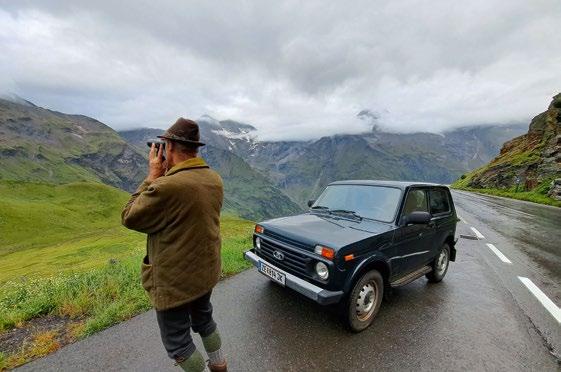



A BMW R 1250 GS in the lavishly equipped Triple Black version, with extra protection bars and a Slip-On Line exhaust, both provided by Akrapovič.


the GS can do a lot in the hands of a skilled rider if clad in appropriate tires, it has become less and less ‘G elände’ (terrain) and more and more ‘ Strasse’ (road) over the years. And I get that: people mainly choose such a bike for road trips, where it performs perfectly, letting you, for example, to stand up and give your posterior a bit of a rest. And just look at it: equipped with optional tubular side guards it provides excellent protection to valuable cylinder heads from damage.

This scenic road was not built to connect two valleys like many other mountain passes. The idea of attracting petrol-based tourism was met with ridicule in 1924, but three years later, Austria, still reeling from the aftermath of WWI, decided to approve the project, which was expected to attract 120,000 visitors a year. The road was opened to traffic in 1935 and three years later 375,000 people drove or rode on it, with the number reaching around 900,000 in recent years. The 48-kilometrelong rollercoaster will set you back 28 euro for a motorcycle and 38 euro for a car. Tip: sleep somewhere nearby and get on the mountain early, before the crowds do.


But I couldn’t avoid the rush hour in Lienz, which I was still happy to have seen. The road from Lienz to Italy is nothing special in itself - quite busy and fairly flat - but the pleasures that await are worth a bit of blandness. Ah, the Dolomites! Probably one of the most enjoyable locations for motorcycle riding. The main reason has to be the extraordinary scenery with jagged peaks, glaciers and high mountain pastures. This exquisite natural environment is criss-crossed by a network of excellent roads, twisted like pretzels. And then there are the restaurants which bring with them a touch of Italy. There’s nothing wrong with a fatty sausage in Munich, and a Vienna steak is quite all right, but Italian cuisine is second to none. Light, simple, delicious. In Cortina d’Ampezzo, I entered the tried-and-true Ristorante Ariston, and even before the waiter thrust the menu into my hands, I stopped him with “Do you still have ravioli with...” “With beetroot? We do. Anything else?” “Busy, ha?” I ask him a moment later while dipping a warm bun in a bit of olive oil. “It’s terrible! We’ve had two great months, but August is crazy. Italians and their cars,” he says shaking his head standing akimbo at the
entrance to the restaurant’s terrace. “Look, just one person per car.”




You have to love Italy. One just becomes more alive here. Chic signorinas, grandfathers on bicycle specials with peaked caps instead of helmets, a waiter who easily convinces you to have something sweet, even if you’re already full. But it is also true that I was blocked in by a flatbed truck in the middle of a Cortina motorcycle parking lot. Something like that didn’t happen in Germany.
It’s August. No, definitely don’t go to the Dolomites when Italians are on vacation, even though the temperatures are perfect for a ride then. And when planning your motorcycle tour among the peaks, try to be somewhat nearby your hotel towards the early afternoon, as storms can and do occur even on a seemingly innocent, sunny day. A rain coverall and an extra pair of warm gloves are essential equipment. Years ago, I remember waking up to motorcycles covered in snow – at the end of August! One of the guests from Brazil in his sixties saw snow for the first time ever and was playing with it like a child. If his GS hadn’t come with heated handlebars, his fingers would have probably gone numb.
By accident, I ended my Alpine trip via an unplanned route. Inquiring about the way to Tolmezzo, an employee at the gas station in Auronzo helpfully explained: “Six kilometres, left.” I, however, turned left into the first available tunnel and found myself in the Piave river valley, in somewhat less populated country. Still touristy, of course, but with an antique shop on the main street, something inconceivable in Cortina or Corvara where boutique stores sell prestigious fashion brands. I had my last coffee in Rigolato, a place squeezed into a narrow gorge, where I would have gladly spent the night if I wasn’t pressed for time. Don’t use a navigation system and don’t plan your trip to perfection, trying to squeeze everything in it. Leave a day or two free and let yourself go with the wind.



-
Wine AND train? Lovers of delectable wine and picturesque landscape can now enjoy a very special experience in the shape of a five-hour train ride through the Vipava valley in Slovenia, where grapevines were planted for the first time about 2000 years ago. This irresistibly charming wine country fascinates with its many unique attributes, top quality wines and old indigenous varieties such as Zelen and Pinela. As you embark on the Wine Train, you are greeted with a glass of local sparkling wine. This is just the first delicacy of the journey with stops along the way where you will personally meet local winemakers and taste the best that Vipava Valley has to offer.
www.vinskivlak.si

An oasis of peace and tranquillity in the heart of Berlin, Vabali Spa resides in the centre of the bustling metropolis and offers a peaceful space to reunite body, mind and soul. This unique day spa will leave a lasting impression, as you are supposed to enter it in the nude. Once inside, let yourself be awed by the stunning and extensive grounds, outstanding architecture and countless authentic Balinese elements which will help you truly experience and enjoy the charm and tranquillity of Bali. More than 20,000 square meters of relaxation await you, so take a look around and find your favourite spot in one of the many saunas containing soothing ceremonies, choose a heated waterbed in a multitude of relaxation rooms, cool off in the pool or enjoy a massage in one of the harmoniously designed treatment rooms. Take off your clothes and enjoy!
www.vabali.de/en/berlin/
No, it’s not what you think! Swingers is the name of a crazy golf venue located in London’s West End, dedicated to the sport’s kitschy past. It takes you back to the roots of mini golf on a course fully furnished with the now faded glamour of 1920s England. Its eye-catching obstacles including ornate Ferris Wheels, rose gardens and the obligatory windmill, make for a course which is both challenging and charming, especially when experienced alongside a well-stocked bar and street food offering. Need we say more? Go and book your 18 holes now. www.swingers.club/uk


If you are a fan of puzzles, anagrams and love to actively explore places you are visiting, then Izola’s outdoor adventure - The Forgotten Secret of Izola - is perfectly suited for you! Explore the alleys and markets of this small Slovenian seaside town to reveal the secrets that might remain hidden on a daily stroll through its compact city centre. After a friendly welcome by the guide in Izolana, House of the Sea, you will soon be placed under the wing of a mysterious person who will, through an app, take you on a journey that will introduce you to the town’s centre and 11 challenges. The clues are fun and the ending is surprising!
www.visitizola.com/en/forgotten-secret/

This is a story about the desire as old as humankind; a desire to face the unknown, to grow and - to fly. It’s a story about a hardworking freestyle rider who knows every stage of a hero’s journey, dark times included.

Great adventures require imagination, courage and a leap of faith. After an amazing career as an FMX (freestyle motocross) rider, competitor and inventor, it was only last October when Tom Pagès, 37, achieved what he never thought was possible. By answering the call to adventure, he went from master to apprentice, from struggle to surrender, from freestyle to rigid rules. The journey led him through the fire of initiation and the mighty storm of emotions. “At times, the level of stress was violent. The pressure was all the way insane, and after my second jump in Avoriaz I felt literally sick from the adrenaline.” The darkest night followed before the third Avoriaz jump set Tom free, but first things first.
The first person to put loads of pressure on Tom was Charles, the “craziest” of the Pagès brothers. “Charles constantly kept pushing me to try new things. He is my older brother, so I would follow him. We watched way too much of Travis Pastrana”, remembers Tom. The Pagès brothers started with BMX and a little wooden ramp with a landing in the lake. It soon became second nature for them to perform tricks during regular MX races. In fact, Charles, who had a massive accident in 2010 which ended his career, gets a lot of credit for the trophies displayed in the old farmhouse near Gerona, Tom’s hideout.
There’s only one way to become an FMX legend – by always inventing new tricks. It took him three years to find the right land to train in privacy. Tom certainly knows pressure, but he also knows patience; the old house was impossible to live in so for the first two years he slept in the courtyard in his van. There, in the middle of nowhere, day in day out, he was doing a lot of the same: eat, train, sleep. Those seemingly effortless tricks needed thousands of repetitions. “I used to practice seven days a week, every day, all year, I never stopped. There was me, my mechanic and my dogs. Now, the nature has started to crowd out the foam and the ramps need to be repainted. It’s actually a bit sad. Yeah, the ramps need maintenance, but I need new experiences.” A classic conflict of interest, one might say.


After his last big win at X Games in Shanghai, the lockdown stopped time. With the competition calendar cleared, Tom could finally think about his life. In the emptiness and absence of stress, he felt it was time to grow. To grow differently. And as all endeavours like this, his started at a crossroads, too. One way ‘comfortably’ led back to the routine while the other way - with no brakes, but a parachute - led into the total unknown. From 2008, when he became the first rider ever to stick a double grab flip, he has tasted the glory many times, but also often ended with a broken heart. Besides winning at the most prestigious competitions, Red Bull
Tom makes sure to point out that he is no pioneer in moto BASE jump. The location in the French Alps, Avoriaz, was chosen to honour Alain Prieur who jumped there in the ‘80s. It must also be acknowledged that Travis Pastrana paved the way for a whole generation of FMX riders, but… “Mine was not a stunt,” says Tom. “People always want to see something crazy, and they saw it, but at the end, for me that was a perfectly calculated operation. And most importantly, I gave my 80 percent to have some room to correct mistakes. I was fully committed to work hard and very serious about not risking my life.” Only after 300 skydives with his friend Vince Reffet and the Soul Flyers in Dubai, Tom flew to Réunion Island to learn from Loïc Jean-Albert. And only after his first BASE jumps from the chopper in the jungle, was he ready to jump from the world’s tallest bridge, the Millau Viaduct, with Aurélien Chatard. He got some final tips from Valentin Delluc, and with Fred Fugen, who took over his overall preparation after Vince tragically died in an accident, he had a top notch team of coaches. Not to even mention the technical team responsible for the parachute, or the giant ramp Tom needed to gain 20 meters in the air… “At the end, you see, I only jumped.”
Ramp height:
7 m, 10 m if scaffolding is included.
Cliff height: 130 m vertical at the exit.
Height reached in double flip: 155 m if we refer to the exit height, 15 m above the ramp, 170 m if we refer to the landing zone.
Jump duration: 3 seconds of trick, 2 seconds of fall, 25 seconds under canopy, 30 seconds in total.
Length cliff projection: 55 m.
Speed: 80 km/h in 4th gear just before the jump Fall speed without canopy: 150 km /h.
Fall speed of the motorcycle under canopy: 15 km/h with the parachute.
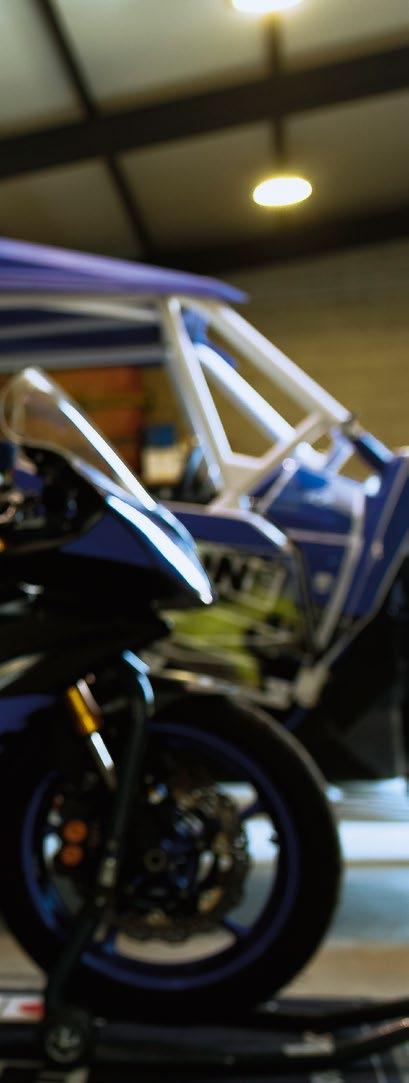

He only jumped… three times into the thin air of the French Alps. “Each jump came with a different stress. The first one was difficult because it was the first, but it went fine, and it set me on fire. The second one was a bit catastrophic - my speed was too high, and I ejected myself too late from the bike. Fred was there to calm me down, but I couldn’t imagine jumping again. That was a rough night, but in the morning the sun rose, and everything seemed less black. My focus shifted from myself to all those people who were there with me - some from the very beginning. I owed a perfect jump to all of us. In competition, it’s only me, so I’m the only one disappointed. Here, I learned a new level of responsibility. All in all, handling the emotional side was far the hardest challenge of all.”
When we try to bring courage on the table, Tom says: “I’m more hardworking than fearless. If you work a lot, you will surely overcome crippling fear, but fear will never disappear. Fear is part of life - what do you feel when you start a new job? Fear! Sure, what I do, it might look reckless, but that’s only the appearance and not the truth because you don’t see all the steps. If I want to repeat that jump, I can’t. I have to follow the steps again. Every step in this journey was the scariest thing I’ve ever done. Then again, it’s so different from the motorbike. It’s

difficult to describe the mental state you need to jump from the cliff, but one thing is for sure: BASE jumpers are nowhere near as crazy as some motocross riders.”
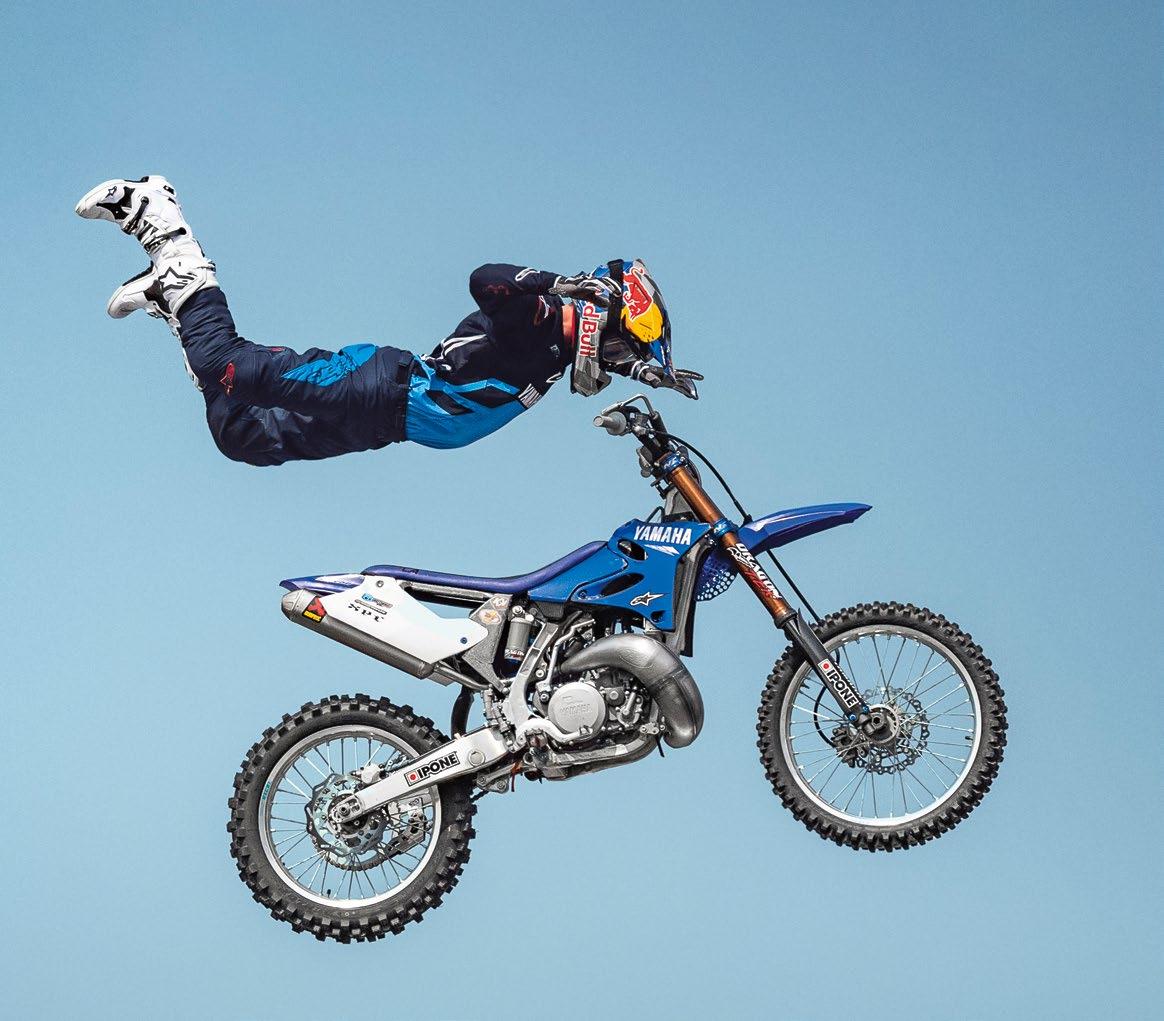

Lately Tom has been racing a lot, and all sorts of machines and he reveals a ‘little’ detail of his next great adventure. “Before I had to be somewhere to win, now I know what it’s like to participate. I love speed, two- or four-wheels, I don’t really care. And the buggy is so much fun - I wouldn’t mind taking it to Dakar. I am French, I grew up with this race, so I absolutely need to go! In the meantime, I’m working on my pilot licence. Spending all this time with the Soul Flyers, who are such great dudes, I got a bug and that’s final. But I am not happy as a passenger, no, I want to become a pilot to understand every little thing about flying. I just passed the PPL theory, so that’s checked. I am really not good at studying, so you can only imagine how badly I want it.”
“Lately I learned a lot about myself and life in general. Well, that was also the plan.” What have you learned? “I learned that I like adventure. That nothing in this world is really impossible. From doing the first lap when I was a kid, to go to the first competition, do the first jump and win the X Games - everything went smoothly and fast... But where does this train stop? It doesn’t. When you catch the flow, one thing leads to another. I’m starting to love this too much! This is the type of life I want to live.”
Now you know: Tom’s dreams just got larger wings, so his garage will soon be expanded into a hangar.
//Si

Na obisku pri Tomu Pagèsu Toma Pagèsa, francoskega motokrosista prostega sloga, smo obiskali v okolici Gerone, kjer živi obkrožen z dvajsetimi hektarji zemljišča in številnimi rampami. Ima že tako polno garažo, da se bo kmalu razširila v hangar. Tom je lani tudi uradno vstopil v klub najbolj drznih pustolovcev. V smučarskem središču Avoriaz je v skok z motorjem s pečine vključil dvojni front flip in dve padali. Neverjetna dogodivščina je hkrati zaznamovala konec njegove tekmovalne kariere in začetek novega življenja. »V zadnjem času sem se veliko naučil o sebi in življenju nasploh. No, to je bil tudi načrt. Naučil sem se, da imam rad pustolovščino. Da nič na tem svetu ni nemogoče. Od prvega kroga, ko sem bil otrok, do odhoda na prvo tekmovanje, prvega skoka in zmage na X Games – vse je šlo gladko in hitro ... Kje pa se ta vlak ustavi? Se ne more ustaviti. Ko ujameš tok, ena stvar vodi k drugi. To mi je postalo preveč všeč! Takšno življenje želim živeti,« je med drugim povedal 37-letni Tom.


“When you return next year, you’ll see a large monument. It will be carved from stone, well 18 large stones to be more exact, and will be in the shape of a full-sized Mercedes limousine. If it were carved out of a single piece, the risk that the monument to the best car of all time could crack would be too great. The stone would be way too massive,” explained Ivan Topić, known to everyone in Imotski as Nota. This beautifully preserved old town in the hinterland of Dalmatia in Croatia, receives media fame due to its love for Mercedes; it has a population of over 10,000 people and more than 8,000 registered Mercedes vehicles. “It’s a world record,” Topić stated confidently, leaning against the roof of his own silver 1972 Benz.
To get to Imotski, we used, what else, a Mercedes. A white W123 from 1980 with a non-turbocharged diesel engine, a 4-speed manual transmission, a large steering wheel without an airbag, a manual sunroof, no air conditioning, a broken radio and equipped with seat covers made of natural sheepskin and installed god-knows-when by the owner.
A summer-like 36 degrees Celsius awaited us as our Mercedes, cruising at 110 km/h and with rolled-down windows, confidently swept past the sign marking the town boundary. Imotski!

There is virtually no street, parking lot, house or family where at least someone does not own or drive a Mercedes. We also came across fami lies where all members owned one. “There are four of us and we all drive Mercedes-Benzes,” a middle-aged lady who runs a convenience store told us as we stopped her on the street.
She introduced us to her son Marko Piplica: “We only drive Mercedes-Benzes. When I sell one, I immediately buy another. It’s the best car in the world, it never breaks down. Even though they have mainly been imported from abroad in recent years and usually come with up to half-a-million kilometres or even more on their odometers, they are still beautiful machines,” the young Croatian army soldier explained succinctly.
Greatest love for W123 and W124

Imotski truly is the land of Mercedes-Benzes. Older versions, though, mainly coming in the guise of W123 and W124 models. “These are two of the best and most durable cars of all time. The general opinion is also that these are the last top-quality models. We all have Mercedes-Benzes in our family and I wouldn’t
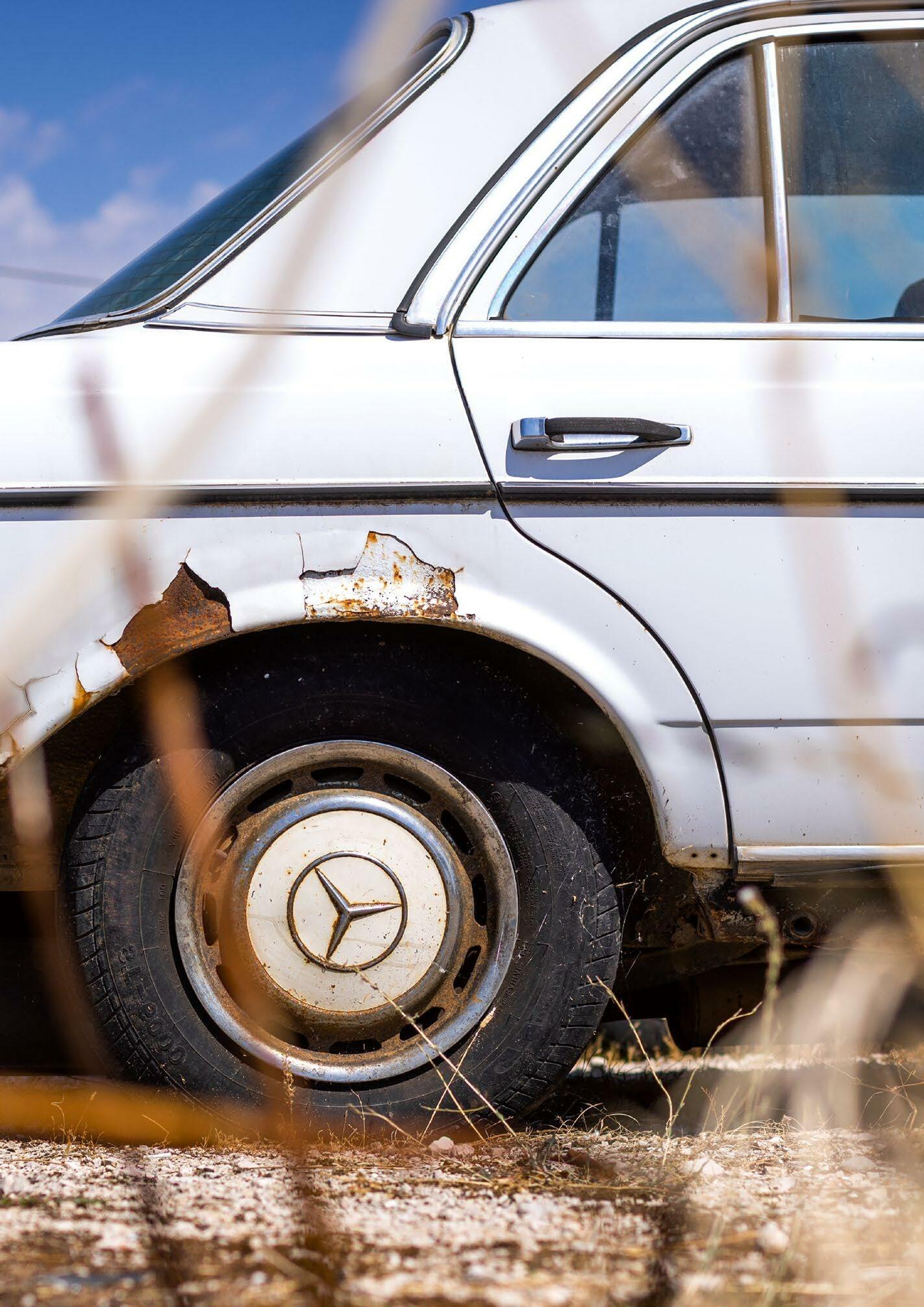




let anyone in my household buy a different marque. Only a Mercedes can park in my courtyard,” Topić, also the president of the club of vintage car lovers, well Mercedes-Benzes, tells us as we sit down for coffee on the main street. But visitors are not the only ones who are scrutinised by Topić: “If a suitor came to ask for my daughter’s hand in marriage, I would first ask him what kind of car he drives. If a Mercedes, then we can continue talking, but if he drives anything else, the story ends right there. I can’t give away my daughter’s hand in marriage to someone who sits in a Fiat or a Japanese car,” Topić says dead-seriously while eyeing our Mercedes 240D with interest. It has been well maintained and its first owner only clocked up 180,000 kilometres. Soon everyone in town knows who we are and where we come from. “It’s beautiful, really beautiful. And so few kilometres. Is it for sale?” many townspeople inquire hopefully.
The cult of Mercedes is not worshiped solely in Imotski. The entire region favours the brand and since Imotski is located close to the border, we hop across to Herzegovina. A village called Ružići, to be exact. It looks the same, it is populated by the same people, just that they are living in a different country. And no surprise, we see old Mercedes-Benzes parked everywhere. There are one or two in front of, or behind, every house, usually in various states of disassembly and being used for spare parts. We spot a garage by the main road. Its yard is full of old MercedesBenzes and what used to be a car showroom now hosts a few well-preserved or restored examples. Owner and mechanic Kamilo Pralas, known locally as Kamo, slowly walks across the yard to greet us. Kamo could talk all day about the Stuttgart-based company, their most successful models, rare series, vintage models, repairs, positive and negative features. We get the feeling that he knows absolutely everything about older Benzes. His yard is home to a never-ending line of vehicles and a large area behind the house is littered with spare parts. Doors, engines, wheels, windows, bare and stripped bodies, parts of the chassis... Kamo gives us a tour of his star-studded kingdom and shows us his pets. These are the models he restored or found himself and they are safely parked under the roof on the ceramic floor of his former car salon and bar. But he knows of a place in Herzegovina with even more Benzes: “If you want to see a Mercedes in front of every house, then drive to Vojnići.” We do!
As we arrive in Vojnići at noon, the town looks dead. The courtyards are deserted, the roads empty. Fortunately, the local bar is open. Can you guess what it’s called? Nope, it’s not


Mercedes, but rather MotoGP. Its owner is a diehard motorcycle rider and amateur racer. “It’s too hot. During the day, people stay at home. They work the fields early in the morn ing, when the sun is not that potent yet. And they will go to work in their Mercedes-Benzes again in the afternoon, after five pm, when the heat subsides,” explains the owner of the modestly decorated bar. We accept the expla nation and go for a čevapčiči (a grilled dish of minced meat) lunch. When we return, Vojnići shows more signs of life. We run into Dejan Pezuljić, standing in front of the first house in the village. His garage is full of Benzes too. Old and slightly less old. Cars and transport vehicles.
“We all own them. Even small lorries. We used to buy new ones at the Autocommerce Mercedes dealership in Ljubljana, Slovenia. They were mainly blue, but some were orange. There were virtually no other colours. Ours still works well and we use it to transport the fruit and vegetables we grow. W123 remains
extremely popular because it is indestructible. And its younger sibling, the W124, was also a great car. If we find one in a poor condition, we remove its seats and use it for work in the fields,” adds Pezuljić, as we sit in his shaded garden sipping the hospitably served coffee and nibbling on juicy homegrown nectarines and grapes. The whole family has gathered around the table, explaining their passion for the brand, which mostly originates from the need for a reliable and high-quality car, which still represents a status symbol today, just like it did when the village was part of Yugoslavia. “When someone left for work abroad, usual ly to Germany, it was shameful if they didn’t return home in a Mercedes,” is a story heard many times while driving around these parts. And we heard some slightly taller tales as well from the locals: “We bought a new Mercedes every year. When the tires wore out after a year or two, selling the used truck and buying a new one in Ljubljana was as easy or even easier than changing the tires. Those were good


There is virtually no street, parking lot, house or family in Imotski where at least someone does not own or drive a Mercedes. We also came across families where all members own one.

times. We made a killing from two farmer’s markets only – the Croatian in Zagreb and the Slovenian in Ljubljana.”





Today’s reality is different. The area is still populated by hard-working and warm-hearted people, always smiling, positive and hospita ble, but new and expensive Mercedes models have disappeared. Those still on the road were mainly bought before the breakup of Yugo slavia. We return to Imotski. Ivan Topić listens attentively to our impressions before pulling out three medals from his bag. “I can see you are good people. You like the same cars we do, you drove here in a very nice W123.” He told us we deserved to be honoured by their oldtim er club and hung metal medals with a threecolor ribbon and a Mercedes sticker around our necks. Gaber placed his in his study, where it reminds him of Imotski, Ružići, Vojnići and all the good people he met there. The remaining two medals went to our children. God only knows if they will understand that they symbol ise immeasurable love and respect for a car brand and time that is long gone. Time that can only be glimpsed in Imotski and Herzegovina, where you can only return to if you are driving a Mercedes.
“What’s your favourite song?” asks our friendly airport host Nadia Haidar. Though somewhat surprised by the question, I manage to answer without much delay: “You can’t go wrong with a bit of AC/DC,” to which she replies: “Would you choose ‘Back in Black’? It would perfectly complement the colour of your new aeroplane.”
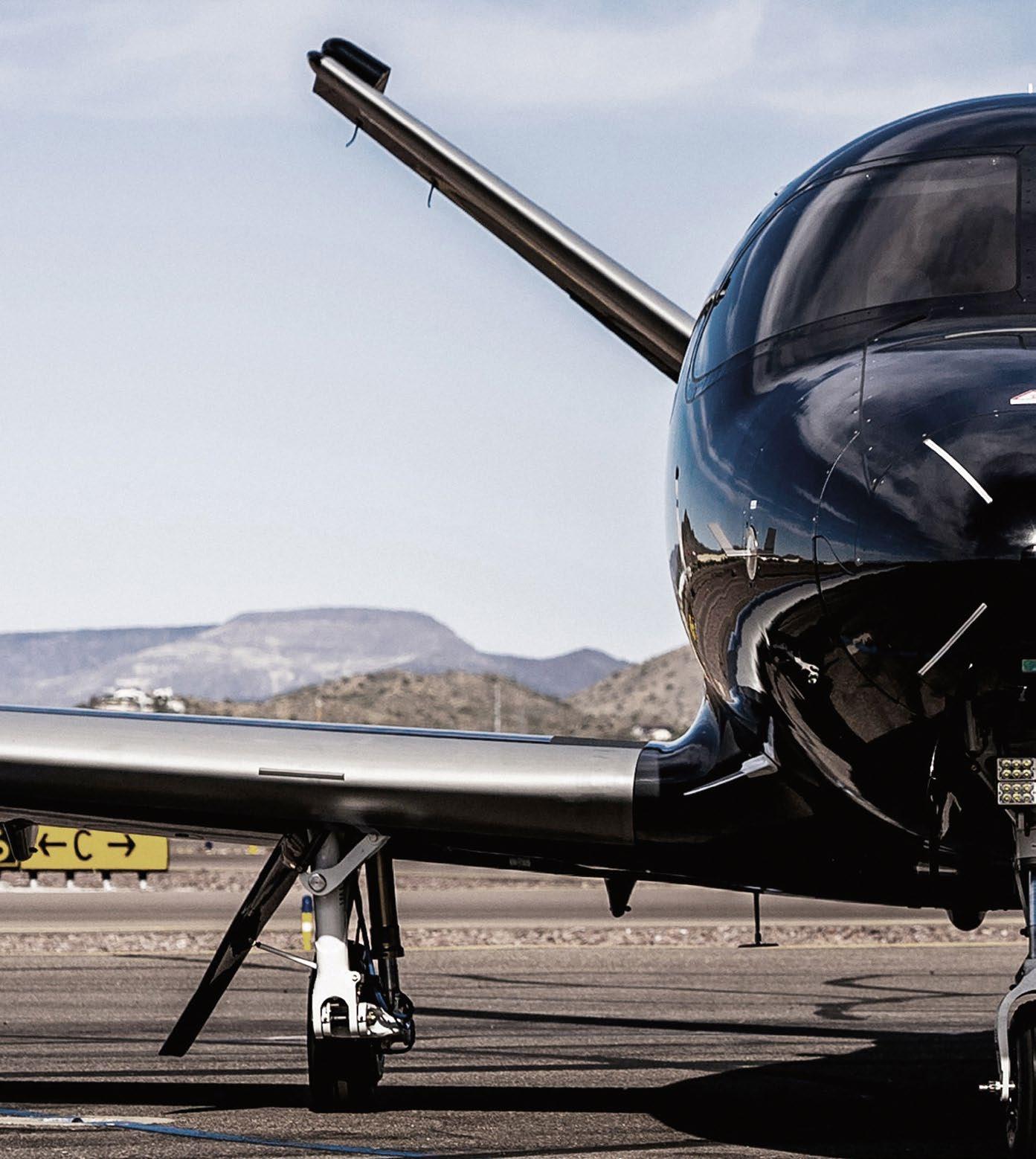 Flying High with Cirrus Vision Jet
Flying High with Cirrus Vision Jet

A visit to Cirrus Aircraft, a company renowned for its top-notch and highly advanced personal aircraft, has been on my mind for quite some time, as I have long been tempted to take a peek inside its Vision Jet, one of the smallest jet aeroplanes to come off a production line, and during my spring travels to the USA, I finally got the opportunity to make a short stopover in Tennessee to see the new training centre in Knoxville, where Cirrus has its amazing new premises. On first glance at the photos, I thought Vision Jet was a prototype that might only be seen flying on the set of the latest James Bond film, but some quick research online proved me wrong and revealed that Cirrus had been successfully building and selling it for years. To date, more than 300 Vision Jets have been built and flown successfully around the globe. “This aeroplane is a best-seller. We build 86 of them every year, and ordering one today will get you on a nearly three-year waiting list,” says Nadia Haidar, who handles PR at Cirrus. During the tour of the training centre we enter a room with a large simulator, where future pilots and owners are trained to fly the plane. The new
Cirrus Training Centre is not only a masterpiece in terms of both equipment and architecture, but also a facility bursting with state-of-the-art technology.
“Cirrus operates in different parts of the US, in different states. The facility in Knoxville was opened because we wanted a one-stop shop that serves as a place for training new pilots, and at the same time handing over new aircraft to its new owners,” says Haidar. So far, more than 600 pilots have been trained to fly the Vision Jet. If you have a Cirrus turboprop licence, you’ll be able to upgrade to the jet in as little as three weeks. In addition to the flight simulator, the theory part of your training in Knoxville will be followed by hands-on instructor-supervised flight sessions. Once you get your licence, Cirrus keeps you up-to-date via a web app on your computer or phone.
Many Vision Jet clients previously had, or still have, one of the cheaper or simpler entry-level models from the Cirrus SR series. “Some of our customers have two aircrafts, some have three or more. As many as 16% of our conventional
entry-level customers subsequently go on to order a Vision Jet,” says Haidar.

The Vision Jet is your entry pass to the aviation jet set and private jet ownership. The prices range from two to three million dollars, which makes it the next step up from a supercar, where prices can be well over a million. We can’t imagine traveling more than 2 thousand km with best passenger cars with the whole family, perhaps up to seven people, from A to B quickly and comfortably.
You might think it’s absurd to compare an expensive car with an aeroplane, but I certainly don’t. “With larger jets, owners almost always hire or employ a pilot. This jet, however, is operated almost entirely independently by its owner, who wants to fly it because it’s relatively easy, safe and fun,” comments Haidar.
Although the Vision Jet has two seats at the front with two sets of controls, it is designed and certified to be flown and operated by just one person. As it turns out, the front seats are the most thrilling spots to be during the flight, although those at the back are not too bad either. Rear passengers are seated in two rows made up of two and three seats respectively. The seats are fully adjustable and can even be removed, in fact a Vision Jet offers 28 possible seating configurations.
The pilot and the front passenger are very well accommodated. Full of Garmin instruments, vents and displays, the cockpit is designed with utmost precision, and, yet again, I can’t help but make the comparison with a car, as I have the feeling I’m riding in a Bugatti, Ferrari or Aston Martin. A combination of exposed carbon fibre, premium leather and beautifully crafted details – everything from the switches to the leather stitching – you won’t find any flaws in this jet. The Vision Jet is a supercar that can fly! And yet it can do so much more.
To date, more than three hundred Vision Jets have been built and flown successfully around the globe. “This aeroplane is a best-seller. We build 86 of them every year, and ordering one today will get you on a nearly three-year waiting list,” says Nadia Haidar, who handles PR at Cirrus.
The Vision Jet offers the ultimate comfort on a journey of up to 2,360 km, depending on the total weight of the aircraft with its passengers. The maximum speed is fixed at a respectable 556 km/h. Passengers in the back can either enjoy their choice of music or radio show in comfort with the Bose headphones, or listen to the gentle hum of the Williams International FJ33-5A engine positioned at the upper rear part of the aircraft, just forward of the two tail fins. At the push of a button a flat-screen TV lowers from the ceiling, but if flicking through TV channels is not your thing, you could instead watch something on your favourite YouTube channel, check emails or arrange your next business event or meeting, as the latest generation of Vision Jet has in-flight internet connectivity.
With Vision Jet, safety is the top priority. Built in its entirety as a single cell, the cabin is constructed of carbon fibre manufactured to the latest standards. The focus is on testing, safety

and detail, as well as on the ongoing checks for the quality and suitability of the built-in materials. It is precisely the construction and materials that allow for such a spacious interior and large panoramic windows. The crew at the hangar inform me that, “the propulsion system is supplied by Williams International, with most of the parts being American-made,” before concluding with, “We fit our aircraft only with the world’s best equipment. With the latest technology we can achieve the very highest safety standards,” all of which feels very reassuring.
I’m one of those people who doesn’t particularly like flying, and tends to feel much safer with their feet firmly on the ground. Perhaps that’s why I’m so impressed by the detail that I see inside. Hey, a large red button on the cabin ceiling, accessible from any seat in the aircraft –what on earth is this? “This is what we call ‘Safe Return’ in case anything happens to one or even both pilots. If there’s nobody on board left to
operate the plane, any passenger can press the red emergency landing button. The autopilot will then return the aircraft to the airport,” say the Cirrus mechanics, who coincidentally also take great pride in the fact this new generation of aircraft only requires an extremely short runway. The Vision Jet can take off on an airstrip that’s shorter than a kilometre, which increases its utility value and the number of airports it can use. Yes, but what if the engine fails? Cirrus has an answer to that too: “This is where our CAPS – Cirrus Airframe Parachute System – comes in, which, much like in ultralights, triggers a parachute opening system. The parachute is attached to the cabin section at multiple points, which allows the aircraft and its passengers to descend safely to the ground, even without the engine running.”
After lunch we are greeted with a surprise. We get into a black Audi SUV and drive to the neighbouring hangar. As the door opens
and we drive in, our car is slowly engulfed in darkness. From inside the gloomy and seemingly empty building, a silhouette of a single parked aircraft becomes visible in the shadows – the unmistakable contours of the Vision Jet, with its distinctive V-tail. Once we step out of the car, the show starts. A spotlight comes on, illuminating nothing else but the prestigious, black-lacquered bird. Music starts blaring from the huge speakers, and I recognise the familiar tune of none other than AC/DC’s Back in Black! While the light show illuminates the aeroplane to the rhythm of the well-known rock hit, we walk the carpet laid out towards the stairway to the aircraft, and then we hear an announcement from the speakers: “Sir, madam, your new aircraft is ready. The Cirrus Vision Jet.”
The Cirrus team has gone the extra mile for our first Vision Jet flight to give us the same experience its customers get when they come to collect their new aeroplanes. “We wanted you to have the same feel and experience as

our buyers,” says Haidar proudly. “We keep the customer up-to-date with progress throughout the entire production process. We co-ordinate details with them and send photographs during production. The buyer has many options for the interior, the materials, the colour of leather upholstery, and even the exterior, which is lacquered in two colours. Blue, black, grey, burgundy, silver, red, yellow and more are available. Then, about three months before the announced collection date, we stop sending photos. We want to build up a little suspense and wow the client when they first set eyes on their new plane, making the experience all the more exciting and unforgettable. Discretely finding out the future owner’s favourite song or band ahead of time, we dim the facility and roll out the carpet,” explains Haidar.




Once we have climbed the stairs to board the aircraft, I take the first seat on the right next to the pilot. A large door opens from the other side of the hangar, leading onto the runway. “Are we clear?” I ask excitedly. It takes one person to get the four of us in this 1.6-tonne flying machine out of the hangar using only a hand-operated trolley. Then the engine starts with its distinctive jet whistle, and off to the runway we go. By the afternoon, a cloudy and rainy morning has turned into a beautiful sunny day over Knoxville. We are greeted by just a handful of clouds as our Vision Jet leaves the ground and sways gently up into the sky, with the subsequent cruise being comfortable and surprisingly calm for an aircraft of this size. Sitting at the front and looking out of the large windows over the fields, houses and lakes below makes for a first-class experience, not unlike that of standing in front of a chalet window with panoramic views. The cockpit view is something quite different from that offered by those small oval side windows in commercial passenger aircraft. While I do have an experienced pilot and instructor beside me, I cannot help but glance at the monitors in front of me, just in case, and attempt to check our altitude and direction. I realise I have no idea how to read the instruments, but I have the feeling I’m in safe hands, nonetheless. I flick the switch to select some soothing music on my headphones and immerse myself in daydreams. In an hour or two I’ll be on the other side of America, ready for my next business meeting.
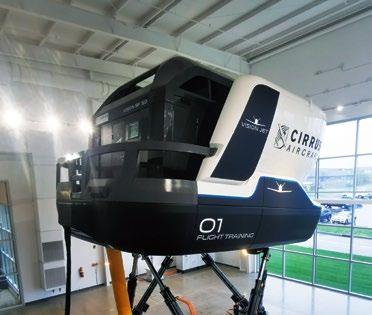
 Obisk v podjetju Cirrus, ki slovi po visokokakovostnih in zelo naprednih letalih za osebno uporabo, sem imel v mislih že dlje časa. Med spomladanskim obiskom ZDA se mi je končno ponudila priložnost za kratek postanek v Tennesseeju – za ogled novega učnega centra v Knoxvillu, kjer ima svoje nove in prekrasno urejene prostore podjetje Cirrus. Že dolgo me je namreč mikalo pokukati v notranjost njihovega Vision Jeta, enega najmanjših reaktivnih letal serijske proizvodnje. Ko sem prvič videl fotografije tega letala, sem si mislil, da gre za prototip, ki bo letel le na snemanja najnovejšega filma o Jamesu Bondu, a kratek skok na splet je hitro pokazal, da Vision Jet ni prototip in da Cirrus svojega reaktivca uspešno izdeluje in prodaja že vrsto let. Do danes so izdelali že več kot 300 letal Vision Jet, ki uspešno letijo po vsem svetu.
Obisk v podjetju Cirrus, ki slovi po visokokakovostnih in zelo naprednih letalih za osebno uporabo, sem imel v mislih že dlje časa. Med spomladanskim obiskom ZDA se mi je končno ponudila priložnost za kratek postanek v Tennesseeju – za ogled novega učnega centra v Knoxvillu, kjer ima svoje nove in prekrasno urejene prostore podjetje Cirrus. Že dolgo me je namreč mikalo pokukati v notranjost njihovega Vision Jeta, enega najmanjših reaktivnih letal serijske proizvodnje. Ko sem prvič videl fotografije tega letala, sem si mislil, da gre za prototip, ki bo letel le na snemanja najnovejšega filma o Jamesu Bondu, a kratek skok na splet je hitro pokazal, da Vision Jet ni prototip in da Cirrus svojega reaktivca uspešno izdeluje in prodaja že vrsto let. Do danes so izdelali že več kot 300 letal Vision Jet, ki uspešno letijo po vsem svetu.


You probably know of Bugatti, maybe you’ve walked past some Tidal loudspeakers, but you’ve almost certainly never heard of Jörn Janczak. You won’t find him on Wikipedia, because the German entrepreneur lives a modest life, away from media and public. But those three subjects are somehow connected - Bugatti produces one

of the most powerful and exclusive sports cars in the world, and on the other hand, Tidal belongs to the top-end of excellent audio components. But Jörn Janczak? He spent a summer some ten years ago in Sardinia, Italy, and had an idea for a very special loudspeaker. Just recently his idea of art, technology and design became reality.



Jörn Janczak started with an idea and drawing of a speaker concept a year before his visit to Porto Cervo in Sardinia. He remembers wanting something very specific in every way that it was designed, executed and combined diametric challenges. “It was something I wanted to have for myself,” says the entrepreneur who started Tidal Audio back in 1999, as he explains the trigger for Bugatti loudspeakers: “I was circling around two Bugatti Veyrons parked in the harbour of Porto Cervo and I admire Bugatti as a brand. The company is never afraid of bringing a bold vision into reality, of doing something never done before and this switched my idea into second gear.” The project, internally called “the world’s first hyper-speaker”, captures the essence of why Janczak pulled the trigger to start it.
Janczak, who grew up in Eastern Germany (formerly DDR - German Democratic Republic), could never imagine Bugatti was at the same time shaping plans to offer its clients high end music systems and expanding its luxury lifestyle portfolio with audio. It took some time for both sides to be ready for the next step, which happened at the High End Show 2019 in Munich when Janczak met with Bugatti. It clicked for both sides. Tidal produces various audio components, but the Bugatti line is incomparable to anything else. Janczak admits he has been a huge car enthusiast for his whole life, so it is easy to understand why the very special name for the Bugatti line was chosen, Royale.


Nowadays Bugatti produces models named Centodieci, Divo, Chiron and Mistral, but there is only one eternal Bugatti - Royale. Experts would know it as Type 41, built between 1926 and 1933 and it was the ultimate car of the period. With an eight-cylinder engine, Royale produced 224kW (300hp) and could reach 200 km/h. Exclusiveness, technology, materials and price were exorbitant, so Bugatti produced only six of those extravagant cars. All six are now, 90 years later, still in use by private owners or belong to various museums. As Bugatti Royale once did, Tidal for Bugatti today means pushing boundaries even further.
Tidal is producing luxury gear, and new products always develop things further, as Janczak speeds up his pace as he begins to explain his new born audio gadget. “We offer almost a small universe of choices, like the big diamond mid-woofers or the Duotone cabinets finished with different combinations of lacquers, polished veneers, carbon fibre and leather. All metal parts are also offered in polished stainless steel as another choice. Milling the stand-frame out of an 80 kg block of stainless steel and polishing it up to wrist-watch quality at the smallest facets is breathtaking, more complicated than for example working with aluminium.” Tidal would not force clients to take something they would not love to have, so each pair can be as individual as the owner is and wants it to look like, or how far they want to go to push the
performance. This is part of the Tidal for Bugatti concept and it includes a bespoke process where the client is deeply involved. It will not be a one-day-wonder as there are already plans for a smaller and larger variant in 2023.
Janczak compares his products with watchmakers A. Lange & Söhne or even more with Greubel Forsey (story published in our Magazine Nr14) and he follows similar principles with Tidal. “Purity in Purpose is one of our major guidelines at Tidal. The only purpose is, and always must be, the performance result from itself. Yes, there are more aspects around itbut only as part of the big picture and vision behind it. What we do together with Bugatti is symbiotic authentic, and it must be.”
A German audio maker with headquarters near Cologne will surely find more than six owners for his Tidal for Bugatti line and as we ask about price, he gets philosophical. “Luxury has never been something to do with a price tag. Take time for example, to me time is the ultimate luxury. Things of priceless value, things of priceless care and passion, produced without several kinds of boundaries around it. Like a fresh handmade bread from a baker who loves his work and gives his best, ticks all the criteria for a luxury product for me, a price just should reflect the effort. But too often a price reflects completely other things behind and luxury is a word that is too often used for things that are not. Just placing or rendering equipment into a posh environment
Tidal produces various audio components, but the Bugatti line is incomparable to anything else. Janczak admits, he has been a huge car enthusiast for his whole life, so it is easy to understand why the very special name for Bugatti line was chosen, Royale.

or beside a fancy car doesn’t rub off back onto the equipment to make it luxurious.” As most of us, readers included, will never have a Bugatti, we can take a risk to mention the price, too.


Tidal for Bugatti Royale starts at 310,000 € and goes up to 470,000 € for clients with different special wishes, including matching source controller MC-1. “To make it successful in the long run, there must be a backbone created of authenticity, quality, and also demand, often more than supply. One cannot study or copy such things as a pattern to use, it simply must drive a brand from its inner core in a native way I think,” Janczak concludes the discussion about the value of his products. He reminds us of Vimberg, as he describes his brand of affordable super speakers. “Not less authentic than Tidal, but with a different approach. I even think given the engineering, materials and how it is made there is no other brand out there in this price range being built like Vimberg at the moment.”


We mentioned Jörn Janczak grew up in the former DDR, a country not exactly famous for offering a colourful variety of technical things of beauty. “I always had a passion for music and all kind of technical things and was dreaming about things we could not get there. Using creativity to get or mimic them was both fun and a necessity. After my education when I was in my early twenties and leading the production management of a company and started to feel
bored with the job, I realised that this kind of creativity is the handle to grab, to make what I always loved to do – bringing my own ideas to life, and constantly evolving them at every possible level, to make things constantly better.”
More strong opinions surface as Janczak explains his views on today’s consumer society. “I don’t buy things that are not for real, as an analogy and literally, so I only do it the way I would expect to have it. Otherwise, I would not enjoy the process of bringing it to life, I could not enjoy the result and I would never buy it myself. And what would be the point of making things only half-heartedly in life?” he adds. The same goes for his whole team, since without it, his visions would exist only on paper or would be built only once. And so, with Bugatti, his vision became true, Janczak doesn’t agree he and his company reached a crossroads with Bugatti: “It’s more of a milestone and development for us. With Tidal for Bugatti, I can do things the way I wanted to do for a very long time without changing Tidal and yet coming from there. It bases on all we do and yet is different in terms of exclusivity and design and even more extreme in the details.”
It seems, Tidal for Bugatti is just a new start for Jörn Janczak and his passion for luxury and fast, exclusive sports cars. Many audio companies cooperate with or support automotive industry on all levels, but it almost feels like they did not make a real impact. The German entrepreneur
knows the reason for that: “Car people are car people, audiophiles are audiophiles. Other than bringing music into a car, there is little to combine or bring them together. Just putting a famous logo onto a product from another category does not make the product any better or more desirable, nor does it rub back onto the product to give it a fancy halo. Actually, this has the exact opposite effect on me and at least I would not want that either on my audio system, my watch or my sunglasses.” Janczak wants to conclude the story personally and emotionally as he adds, “Royale is the project with my most personal fingerprint and passion following my visions and inspirations for a perfect sonic transducer concept in every possible detail. Working together with Bugatti created something I always defined as the holy grail of industrial design; a perfectly round loop out of the only reason why it exists and answering it with the only possible perfect execution for it.” You might have known Bugatti for a long time, now you understand why Tidal is an example of perfection, but one thing is for sure - thanks to Bugatti, Jörn Janczak is now known to an even wider circle of fans of exclusive loudspeakers.
MotoGP journalist and author Mat Oxley has been in love with motorcycles for almost 50 years. These are some of his favourite sounds.
Sound is important in motorcycling – not the quantity, necessarily, but the quality, because a highly tuned engine can make music, beautiful music.
That’s certainly what I thought when I was 17 or 18 and bought a straight-through twointo-one Piper Megaton pipe for the second motorcycle in my life, a Honda CB250K4. I thought the Piper sounded superb. Others disagreed, shaking their fists at me as I rode past. And then there was the policeman who heard me coming, stepped out into the road and lifted his hand to command me to stop, so he could tell me that I was a menace to society. I sailed past him, because the K4’s drum brakes were next to useless…
they were. Which may be why my favourite sound of a TZ750 was a bit more subtle; standing in the paddock, gawping at one of these otherworldly machines being warmed up by a mechanic, blipping the throttle. The crackle of a well-jetted two-stroke and the rattle of a dry clutch is a beautiful thing and very rarely heard since Grand Prix racing went four-stroke.
Two-stroke 500s ruled the racing world for decades but the reality is that they mostly sounded like tricked-up scooters, whereas the earth moves every time a MotoGP fourstroke comes rumbling by. Four-strokes are usually friendlier than twostrokes, but a full-prototype MotoGP engine can sound scarier than anything, which, of course, is exactly how a 300-“horsepower” motorcycle should sound.
by Mat Oxley illustration Natan Eskubike of the 21st century. The three-cylinder, Cosworth-designed engine (basically three cylinders from a ten-cylinder three-litre Formula 1 engine) and its Akrapovič ‘silencer’ sounded wonderful, like a tumult of bellowing bassoons at the front of an ancient army, perhaps going into battle against that legion of two-stroke monsters from the Gates to Hell. British rider Jeremy McWilliams raced the Cube during 2004, the bike’s final year in the MotoGP World Championship. “I remember the first time I tested the Cube,” he recalls. “I walked up to the bike to get acquainted with it and when I got close my chest started reverberating from the sound and vibration. And when you got on the bike the pulse and the sound went right through you!”
In those days – the late 1970s – racetracks were dominated by two-strokes: Yamaha TZ250s and 350s, Suzuki RG500s and Yamaha’s mighty TZ750, which ruled big-bike racing for years. A grid full of TZ750s heading towards you, as you gripped the guardrail at Turn One, sounded like Gates to Hell had been opened and you were about to be gobbled up by a horde of vicious monsters, which in fact wasn’t far from the truth. Some riders of that era called those big two-strokes “collarbone munchers,” because that’s what
I recall the early years of 990cc MotoGP, when Aprilia unleashed its RS Cube. I was wandering down pit lane during practice for the 2002 Spanish Grand Prix at Jerez, while a senior Dorna official was giving a D-list celebrity a personal tour, the pair of them wandering past the various factory garages. As they walked past the Aprilia garage a few mechanics rolled out an RS Cube and fired up the engine. The D-list celeb seemed to rise half a metre off the ground, uttering a terrified shriek of surprise. I chuckled to myself. Twenty years later the Cube is still rated by many fans and paddock people as the best-sounding Grand Prix
Mat Oxley, new columnist
Mat Oxley has been a motorcycle journalist for more than four decades, covering MotoGP full-time since 1988. During his own racing career he won an Isle of Man TT and took third place in the Endurance World Championship, scoring secondplace finishes in the Le Mans and SpaFrancorchamps 24 hours. He is based in London, UK.
And that’s exactly what a great rock and roll band or hip-hop act feels like when you’re at a gig – the music goes right through you, becomes a part of you. And that’s one reason why I’ll never love electric motorcycle racing. The article here does not necessarily correspond with the opinions of Akrapovič d.d., the publishers or the editors.
We will never forget the countless hours we spent together over all the years to push the boundaries of performance to even higher levels.
Our gratitude goes out to everyone at Team Suzuki Ecstar for the trust shown in Akrapovič throughout our partnership. We will always be honoured to have provided the exhaust for the 2020 MotoGP World Championship–winning Suzuki GSX-RR.

Achieve unrivalled performance, improve the design, and own the tarmac with a race-proven Akrapovič exhaust system. It is quality you can see, hear, and touch – all stemming from supreme workmanship, technological knowhow, and the finest materials.
Akrapovič d.d.

Malo Hudo 8a, 1295 Ivančna Gorica, Slovenia / www.akrapovic.com
GENERAL WARNING Because of the world-wide distribution of Akrapovič d.d. products, neither Akrapovič d.d. nor any of its subsidiaries make any representation that the products comply with the air and/ or noise emissions laws, or labeling laws, of any jurisdiction. The purchasers are entirely responsible for informing themselves of the applicable laws where the products are to be used and to comply with those laws. USA WARNING Various U.S. states and the U.S. federal government have individual laws regulating the use of aftermarket exhaust parts and systems, especially as those parts and systems modify, remove, or replace original equipment catalysts. Please consult the appropriate laws in your area before installing any aftermarket part or system on your vehicle to ensure compliance with all applicable laws. Neither Akrapovič d.d. nor any of their subsidiaries or the sellers of the parts or systems make any representation that any of their parts or systems comply with any such laws.
CALIFORNIA WARNING California laws prohibit the use of any aftermarket exhaust part or system that modifies, removes or replaces original equipment catalysts unless the California Air Resources Board has issued an Executive Order regarding such part or system or unless the part or system is exempted by being used only on racing vehicles on closed courses. Neither Akrapovič d.d. nor any of their subsidiaries make any representation that any of their parts or systems has received such an Executive Order or that any of their parts or systems conform with the racing vehicles exemption. The purchasers are entirely responsible for informing themselves of applicable California laws and to comply with those laws.